LG Electronics USA MG280D Cellular/PCS GSM Phone with Bluetooth User Manual
LG Electronics USA Cellular/PCS GSM Phone with Bluetooth
Users Manual

MG280d User Guide
- English

How to Use Touch
Button
5
Introduction 7
For Your Safety 8
Guidelines for safe and
efficient use 9
features 14
Parts of the phone
Display information 18
On-Screen Icons
Installation 20
Installing the SIM card and
the handset battery
Charging the battery 21
Disconnecting the charger
22
General functions 23
Making and answering calls
Entering text 25
Changing the text input
mode
Contacts 28
Selecting Functions
and Options 29
In-Call Menu 30
During a call
Multiparty or conference
calls 31
Menu Tree 33
Profiles 35
Activate
Personalise
Rename 36
Call register 37
Missed calls
Received calls
Dialled calls
All calls 38
Delete recent calls
Call charges
Call duration
Call costs
Settings
GPRS information 39
Call duration
Data volume
Tools 40
Favourites
Alarm clock
Calculator
Unit converter 41
World time
SIM-Menu
Table of Contents
Table of Contents
2
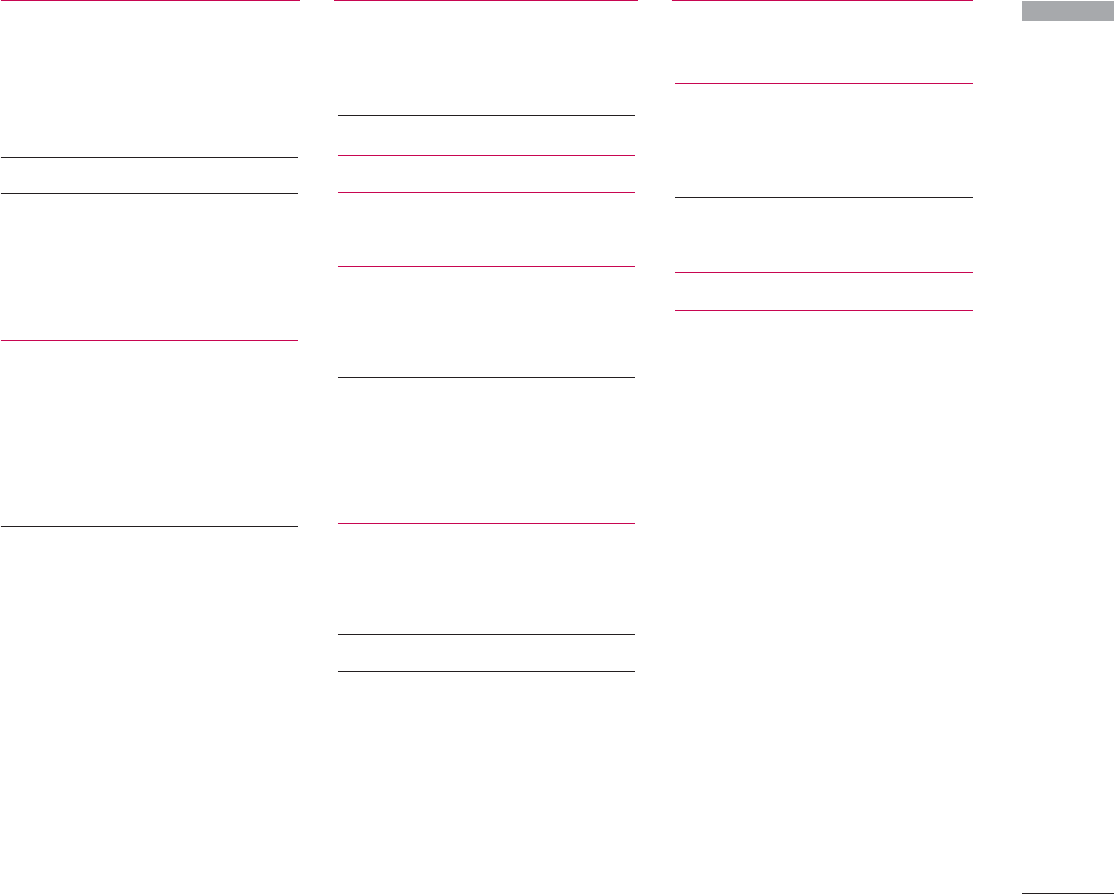
Organiser 42
Contacts
Search contacts
Add new
Caller groups 43
Speed dial 44
Own number
My business card
Settings
Calendar 46
Add new
View daily schedules
Delete past
Delete all
Go to date 47
Set alarm tone
Memo
Messages 48
New message
Write text message
Write multimedia message 49
Inbox 51
Drafts 52
Outbox
Listen to voice mail 55
Info message
Read
Topics 54
Templates
Text templates
Multimedia templates
Settings 55
Text message
Mulitimedia message
Voice mailbox number 57
Info message 58
Push message
Multimedia 58
Camera
Video camera 59
Voice recorder
Record
View list 60
MP3
Photo album 62
Video album 63
Settings
Camera
Video camera
Table of Contents
3

Browser 64
Home 65
Bookmarks
Go to URL
Settings
Profiles
Cache 67
Cookie
Clear cache
Clear cookie
Security
My stuff 68
Games & apps
Games & apps
Profiles
Videos 82
Photos
Music 73
Text
Images 74
Sounds
Others 75
Settings 76
Date & time
Date
Time
Display
Wallpaper
Menu colour
Standby text
Backlight 77
Brightness
Network name
Home screen shortcut
Dial font colour
Power saving
Language
Connectivity
Bluetooth
Modem 80
Network
GPRS attach 81
Calling
Call divert
Answer mode 82
Send my number
Call waiting 83
Minute minder
Auto redial
Security
PIN code request
Handset lock 84
Call barring
Fixed dial number 85
Change codes
Touchpad lock
Memory status 86
Reset settings
Accessories 87
Technical Data 88
Table of Contents
Table of Contents
4

Cautions for Touch
Buttons
1. Make sure your hands are clean and dry.
- Remove all moisture from the surface of
your hands or the touch buttons in a
humid environment.
2. You do not need to press hard on the
touch buttons to make it work normally.
Keep product from severe impact, as
sensors of the touch buttons may be
damaged.
3. Use the tip of your finger to press exactly
on the touch button you want, being
careful not to touch the buttons for other
functions.
4. When both the home screen and touch
button lights are off, pressing a touch
button will not turn on the home screen
light. Press the End button and the home
screen light will turn back on (touch
buttons do not work when the touch
button lights are off).
5. If the slide is closed and the Touch
Protection function is on, during calls the
Touch button Lock function is
automatically enabled. (For details, see
‘Touch Button Status When Using Mobile
Phone’.)
]
This product’s buttons on the slide are touch buttons.
]
Be sure to read “Cautions for Touch Buttons” before using touch buttons.
How to Use Touch Button
How to Use Touch Button
5

6. Touch buttons may not work normally if a
mobile phone case or plastic is covering
the touch buttons. Also, touch buttons
may not work normally if you are using it
wearing a glove.
7. Keep metal and other conductive material
away from the surface of touch buttons, as
contact with them may result in error.
Touch Button Status
When Using Mobile
Phone
When the slide is closed, to prevent
indiscreet action of the touch buttons whilst
using the phone or during calls, the Touch
Protection function is automatically enabled.
(In this case, the touch buttons will not work
even if they are pressed)
1. When slide is closed
- When the slide is closed, Touch Protection
function is automatically enabled. (Opening
the slide will automatically disable it.)
- To disable Touch Protection when slide is
closed,press volume button twice.
- After disabling Touch Protection, if there is
no button action for a certain duration,
Touch Protection function is enabled again.
2. During calls
- During calls, regardless of slide
status,Touch Protection function is
automatically enabled.
- To disable Touch Protection, press the MP3
button or number button, button, or
button.
- After disabling Touch button Lock, if there
is no button action for a certain duration,
the Touch Protection function is enable
again.
How to Use Touch Button
How to Use Touch Button
6

Congratulations on your purchase of the
advanced and compact cellular
phone, designed to operate with the latest
digital mobile communication technology.
Introduction
Introduction
7
This user’s guide contains important
information on the use and operation of
this phone. Please read all the information
carefully for optimal performance and to
prevent any damage to or misuse of the
phone. Any changes or modifications not
expressly approved in this user’s guide
could void your warranty for this
equipment.

8
For Your Safety
Important Information
This user guide contains important information on the use and
operation of this phone. Please read all the information
carefully for optimal performance and to prevent any damage
to or misuse of the phone. Any changes or modifications not
expressly approved in this user guide could void your warranty
for this equipment.
Before You Start
Safety Instructions
WARNING! To reduce the possibility of electric shock, do not
expose your phone to high humidity areas, such as the
bathroom, swimming pool, etc.
Always store your phone away from heat. Never store your
phone in settings that may expose it to temperatures less than
32°F or greater than 104°F, such as outside during extreme
weather conditions or in your car on a hot day. Exposure to
excessive cold or heat will result in malfunction, damage
and/or catastrophic failure.
Be careful when using your phone near other electronic
devices. RF emissions from your mobile phone may affect
nearby in adequately shielded electronic equipment. You
should consult with manufacturers of any personal medical
devices such as pacemakers and hearing aides to determine if
they are susceptible to interference from your mobile phone.
Turn off your phone in a medical facility or at a gas station.
Never place your phone in a microwave oven as this will
cause the battery to explode.
IMPORTANT! Please read the TIA SAFETY INFORMATION on
page 78 before using your phone.
Safety Information
Read these simple guidelines. Breaking the rules may be
dangerous or illegal. Further detailed information is given in this
user guide.
]Never use an unapproved battery since this could damage
the phone and/or battery and could cause the battery to
explode.
]Never place your phone in a microwave oven as it will
cause the battery to explode.
]Do not dispose of your battery by fire or with hazardous or
flammable materials.
]Make sure that no sharp-edged items come into contact
with the battery. There is a risk of this causing a fire.
]Store the battery in a place out of reach of children.
]Be careful that children do not swallow any parts such as
rubber plugs (earphone, connection parts of the phone,
etc.). This could cause asphyxiation or suffocation.

9
For Your Safety
]Unplug the power cord and charger during lightning storms
to avoid electric shock or fire.
]When riding in a car, do not leave your phone or set up the
hands-free kit near to the air bag. If wireless equipment is
improperly installed and the air bag is activated, you may be
seriously injured.
]Do not use a hand-held phone while driving.
]Do not use the phone in areas where its use is prohibited.
(For example: aircraft).
]Do not expose the battery charger or adapter to direct
sunlight or use it in places with high humidity, such as a
bathroom.
]Never store your phone in temperatures less than- 4°F or
greater than 122°F.
]Do not use harsh chemicals (such as alcohol, benzene,
thinners, etc.) or detergents to clean your phone. There is a
risk of this causing a fire.
]Do not drop, strike, or shake your phone severely. Such
actions may harm the internal circuit boards of the phone.
]Do not use your phone in high explosive areas as the phone
may generate sparks.
]Do not damage the power cord by bending, twisting, pulling,
or heating. Do not use the plug if it is loose as it may cause
a fire or electric shock.
]Do not place any heavy items on the power cord. Do not
allow the power cord to be crimped as it may cause fire or
electric shock.
]Do not handle the phone with wet hands while it is being
charged. It may cause an electric shock or seriously
damage your phone.
]Do not disassemble the phone.
]Do not place or answer calls while charging the phone as it
may short-circuit the phone and/or cause electric shock or
fire.
]Only use the batteries, antennas, and chargers provided by
LG. The warranty will not be applied to products provided by
other suppliers.
]Only authorized personnel should service the phone and its
accessories. Faulty installation or service may result in
accidents and consequently invalidate the warranty.
]Do not hold or let the antenna come in contact with your
body during a call.
]An emergency call can be made only within a service area.
For an emergency call, make sure that you are within a
service area and that the phone is turned on.

10
For Your Safety
FCC RF Exposure Information
WARNING! Read this information before operating the phone.
In August 1996, the Federal Communications (FCC) of he United
States, with its action in Report and Order FCC 96-326, adopted
an updated safety standard for human exposure to radio
frequency (RF) electromagnetic energy emitted by FCC
regulated transmitters. Those guidelines are consistent with
the safety standard previously set by both U.S. and
international standards bodies.
The design of this phone complies with the FCC guidelines and
these international standards.
CAUTION
Use only the supplied and approved antenna. Use of
unauthorized antennas or modifications could impair call
quality, damage the phone, void your warranty and/or result in
violation of FCC regulations. Do not use the phone with a
damaged antenna. If a damaged antenna comes into contact
with skin, a minor burn may result. Contact your local dealer
for a replacement antenna.
Body-worn Operation
This device was tested for typical body-worn operations with
the back of the phone kept 0.6 inches (1.5cm) between the
user’s body and the back of the phone. To comply with FCC RF
exposure requirements, a minimum separation distance of 0.6
inches(1.5cm) must be maintained between the user's body
and the back of the phone. Third-party belt-clips, holsters, and
similar accessories containing metallic components should not
be used. Body-worn accessories that cannot maintain 0.6
inches(1.5cm) separation distance between the user's body
and the back of the phone, and have not been tested for typical
body-worn operations may not comply with FCC RF exposure
limits and should be avoided.

11
For Your Safety
Vehicle Mounted External Antenna
(optional, if available)
A minimum separation distance of 8 inches (20cm) must be
maintained between the user/bystander and the vehicle
mounted external antenna to satisfy FCC RF exposure
requirements. For more information about RF exposure, visit
the FCC website at www.fcc.gov
FCC Part 15 Class B Compliance
This device and its accessories comply with part 15 of FCC
rules. Operation is subject to the following two conditions:
(1) This device and its accessories may not cause harmful
interference, and (2) this device and its accessories must
accept any interference received, including interference that
may cause undesired operation.
Cautions for Battery
]Do not disassemble.
]Do not short-circuit.
]Do not expose to high temperature: 60°C (140°F).]
]Do not incinerate.
Battery Disposal
]Please dispose of your battery properly or bring to your
local wireless carrier for recycling.
]Do not dispose in fire or with hazardous or flammable
materials.
Adapter (Charger) Cautions
]Using the wrong battery charger could damage your phone
and void your warranty.
]The adapter or battery charger is intended for indoor use
only.
Do not expose the adapter or battery charger to direct sunlight
or use it in places with high humidity, such as the bathroom.
Part 15.21 statement
" Change or Modifications that are not expressly approved by the manufacturer could void
the user's authority to operate the equipment. "
Part 15.105 statement
This equipment has been tested and found to comply with the limits for a class B digital device,
pursuant to Part 15 of the FCC Rules.
These limits are designed to provide reasonable protection against harmful interference in a
residential installation.
This equipment generates uses and can radiate radio frequency energy and, if not installed and used
in accordance with the instructions, may cause harmful interference to radio communications.
However, there is no guarantee that interference will not occur in a particular installation. if this
equipment does cause harmful interference or television reception, which can be determined by
turning the equipment off and on, the user is encouraged to try to correct the interference by one or
more of the following measures:
- Reorient or relocate the receiving antenna.
- Increase the separation between the equipment and receiver.
- Connect the equipment into an outlet on a circuit different from that to
which the receiver is connected
- Consult the dealer or an experienced radio/TV technician for help.

Parts of the phone
Open view
features
features
14
Navigation keys
vIn standby mode:
i
Briefly: List of Favourites
j
Briefly: List of Contacts
k
Briefly: List of Profiles
(Hold down: Activate/
Deactivate Vibrate mode)
l
Briefly: List of Messages
vIn menu: scroll up & down

features
15
Send key
vDial a phone number and answer a call.
v
In standby mode:
shows a history of calls
made, received, and missed.
Confirm key
Selects menu options and confirms actions.
Clear key
Deletes a character with each press.
Hold the key down to clear all input.
Use this key to go back to a previous screen.
Left soft key/ Right soft key
These keys perform the function Indicated in the
bottom of the display.

Left side view Right side view
features
features
16
End key
vSwitch on/off
(hold down)
vEnd or reject a call.
Camera/MP3 and Multimedia
hot key
vActivates the MP3 player (long
press) and Multimedia menu (short
press) directly.
Note
vTo protect the sense of
hearing while Slide open,
maximum volume level is 3.
Side keys
vIn standby mode (opened)
:
Volume of key tone
vIn standby mode (closed):
Short press - The main LCD light
on.
Long press - Only display a
wallpaper.
vIn menu: scroll up & down
vDuring a call: volume of the
earpiece

Rear view
features
17
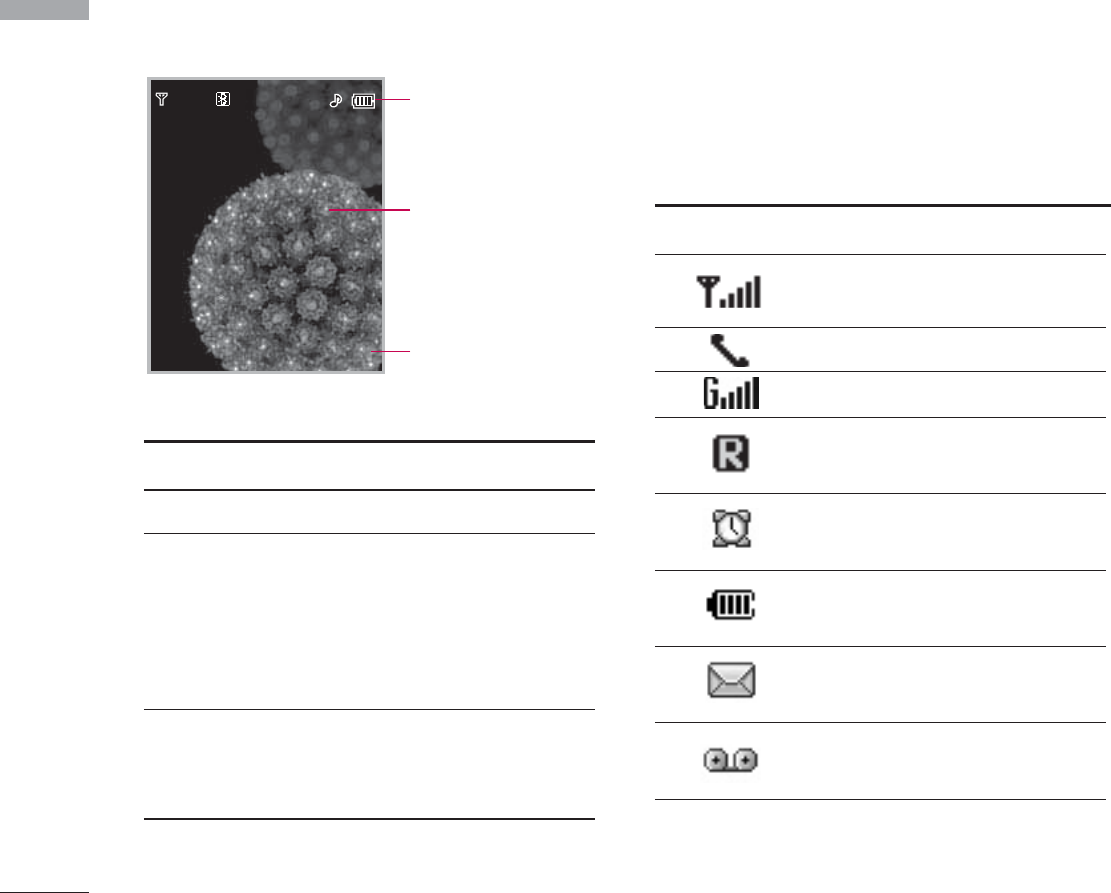
Display Information
Icon area
Text and graphic
area
Soft key
indications
Area Description
First line Displays various icons.
Middle lines Display messages,
instructions and any
information that you enter,
such as number to be
dialled.
Last line Shows the functions
currently assigned to the
two soft keys.
The screen displays several icons. These are
described below.
On-Screen Icons
Icon/Indicator
Description
Tells you the strength of the
network signal.
Call is connected.
You can use GPRS service.
Shows that you are using a
roaming service.
The alarm has been set and
is on.
Tells you the status of the
battery.
You have received a text
message.
You have received a voice
message.
features
features
18
'SRXEGXW
'SRXEGXW
'SRXEGXW
'SRXEGXW
'SRXEGXW
'SRXEGXW
'SRXEGXW
'SRXEGXW
'SRXEGXW
'SRXEGXW
'SRXEGXW
'SRXEGXW
'SRXEGXW
'SRXEGXW
1IRY
1IRY
1IRY
1IRY
1IRY
1IRY
1IRY
1IRY
1IRY
1IRY
1IRY
1IRY
1IRY
1IRY
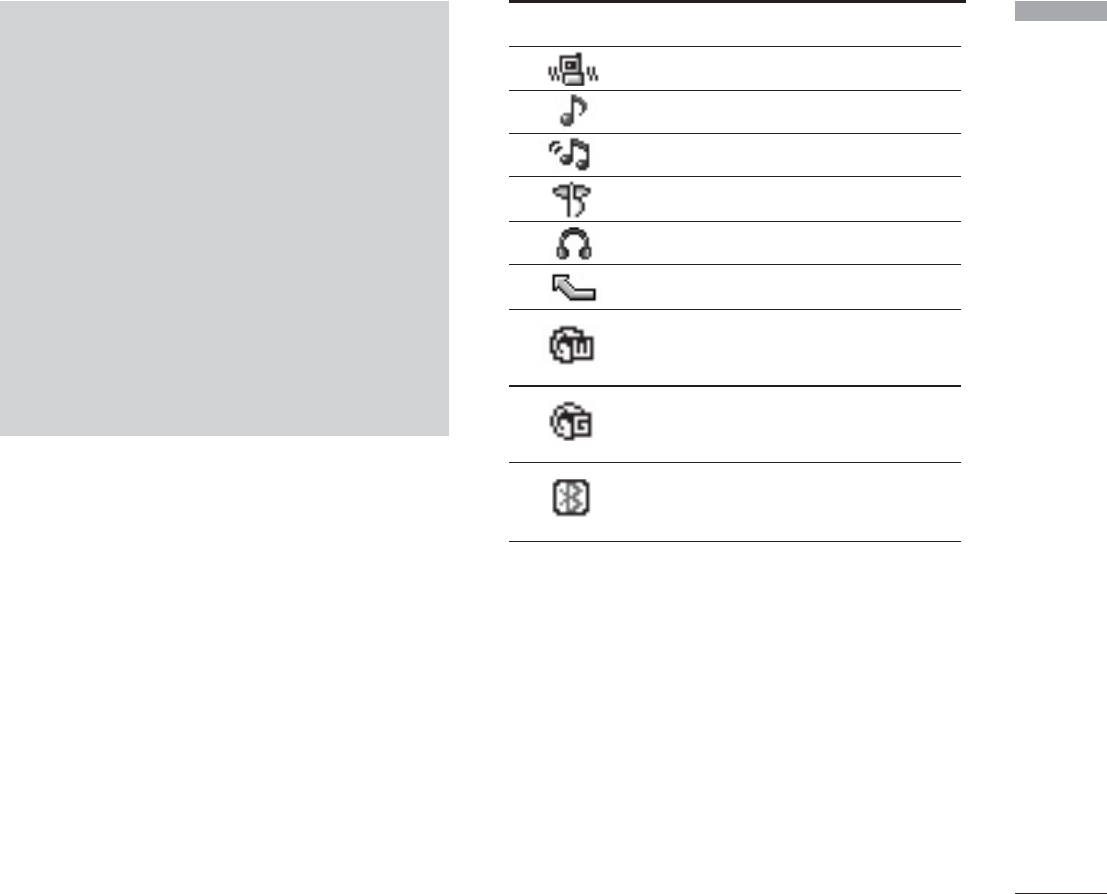
Icon/Indicator
Description
Vibrate only menu in profile.
General menu in profile.
Loud menu in profile.
Silent menu in profile.
Headset menu in profile.
You can divert a call.
Indicates that the phone is
accessing the WAP.
Indicates that you are using
GPRS.
You have activated
Bluetooth menu.
Note
v
The quality of the conversation may
change depending on network
coverage. When the signal strength is
below 2 bars, you may experience
muting, call drop and poor audio.
Please refer to this signal as an
indicator for your calls. When there
are no bars, that means that there is
no network coverage: in this case, you
won’t be able to access the network
for any service (call, messages and so
on).
features
19

Installing the SIM card
and the handset battery
Make sure the power is off before you remove
the battery.
1. Remove the battery.
Press and hold down the battery release
button and slide the battery down.
2. Install the SIM card.
Insert and slide the SIM card into the SIM
card holder. Make sure that the SIM card is
inserted properly and that the gold contact
area on the card is facing downwards.
To remove the SIM card, press down lightly
and pull it in the reverse direction.
To insert the SIM card
To remove the SIM card
Note
vThe metal contact of the SIM card can
be easily damaged by scratches. Pay
special attention to the SIM card while
handling. Follow the instructions
supplied with the SIM card.
Installation
Installation
20

3. Install the battery.
Slide the battery upwards until it snaps back
into place.
Charging the Battery
Before connecting the travel adapter to the
phone you must first install the battery.
1. Ensure the battery is fully charged before
using the phone for the first time.
2. With the arrow facing you as shown in the
diagram push the plug on the battery
adapter into the socket on the side of the
phone until it clicks into place.
3. Connect the other end of the travel
adapter to the mains socket. Use only the
charger included in the box.
4. The moving bars of battery icon will stop
after charging is complete.
Installation
21

Disconnecting the
charger
Disconnect the travel adapter from the
phone as shown in the diagram below.
WARNING!
• Unplug the power cord and charger during
lightning storms to avoid electric shock or fire.
• Make sure that no sharp-edged items such as
animal teeth or nails, come into contact with the
battery.
There is a risk of this causing a fire.
• Do not place or answer calls while charging the
phone as it may short-circuit the phone and/or
cause electric shock or fire.
CAUTION!
• Do not force the connector as this may damage
the phone and/or the travel adapter.
• If you use the battery pack charger out of your
own country, use an attachment plug adaptor
for the proper configuration.
• Do not remove your battery or the SIM card
while charging.
Installation
Installation
22
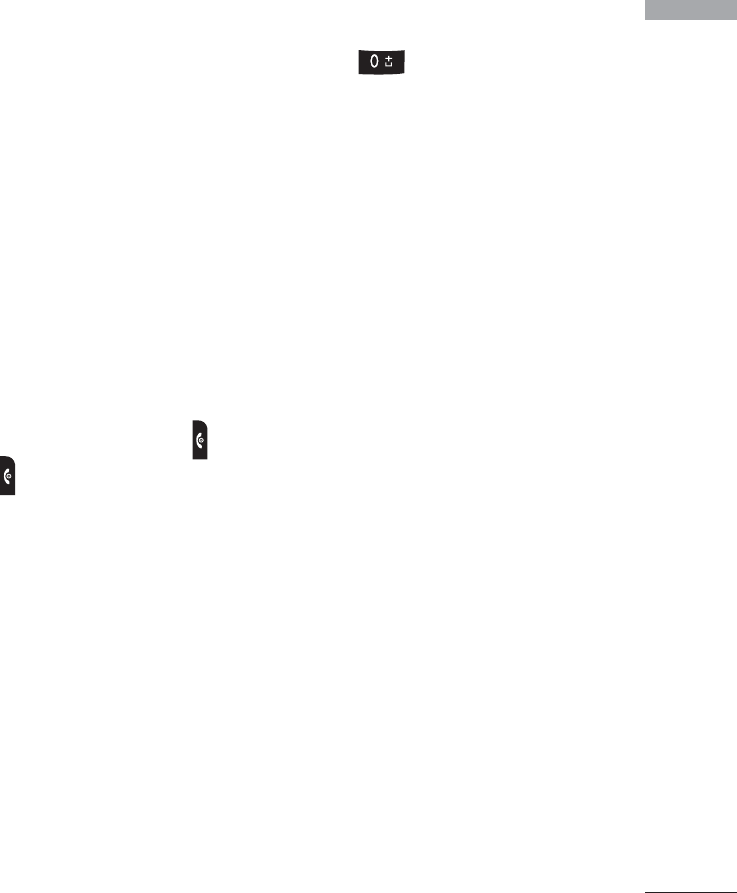
Making and answering
calls
Making a call
1. Make sure your phone is switched on.
2. Enter a phone number, including the area
code.
]
Press and hold the clear key
b
to
erase the entire number.
3. Press the send key
a
to call the
number.
4. To end the call, press the end key .
Making a call from the call
history list
1. In standby mode, press the send key
a
,
and the latest incoming, outgoing and
missed phone numbers will be displayed.
2. Select the desired number by using the
up/down navigation keys.
3. Press
a
to call the number.
Making an international call
1. Press and hold the key for the
international prefix. The ‘+’ character
automatically selects the international
access code.
2. Enter the country code, area code, and the
phone number.
3. Press
a
to call the number.
Ending a Call
When you have finished your call, press the
end key.
Making a call from the
phonebook
You can save the names and phone numbers
dialled regularly in Contacts. You can save
them to the SIM card and/or phone memory.
You can dial a number by simply looking up
the desired name in the phonebook and
pressing the
a
key.
General Functions
General Functions
23
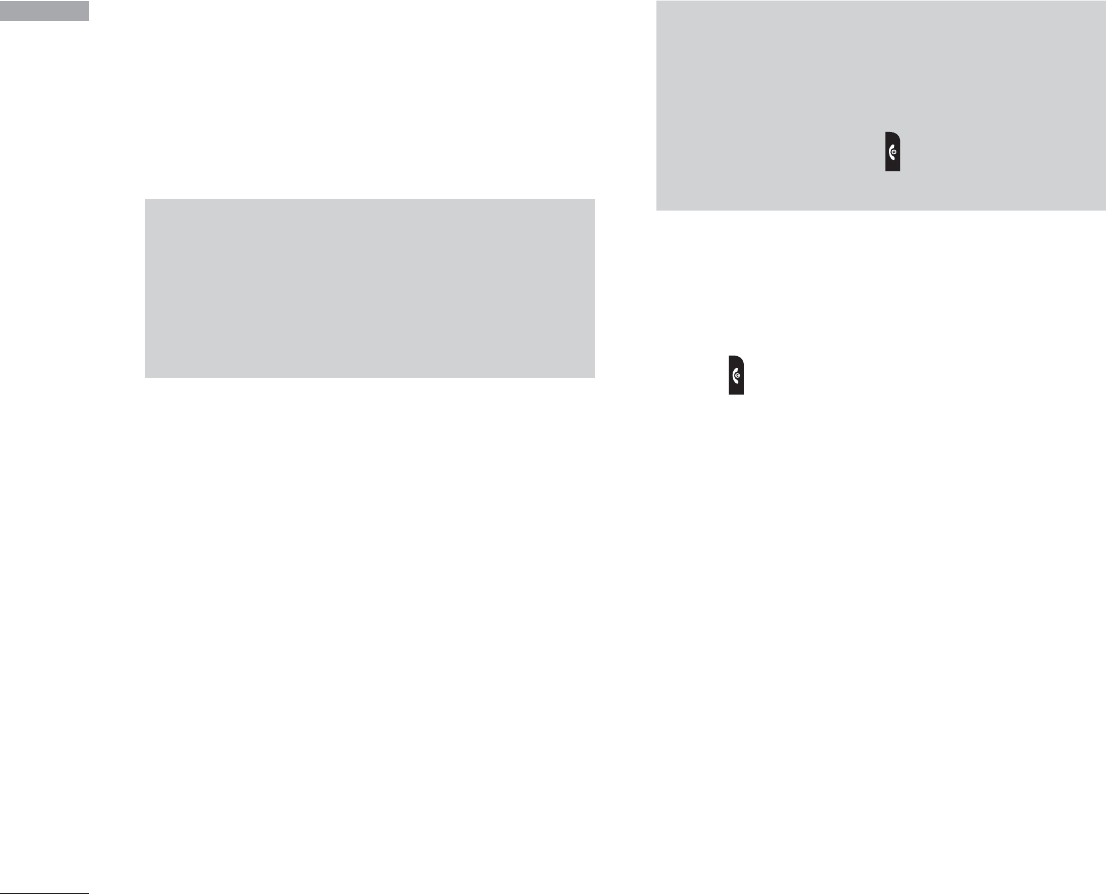
Adjusting the volume
If you want to adjust the earpiece volume
during a call, use the side keys
o
. Press the
up side key to increase and down side key to
decrease the volume.
Answering a call
When you receive a call, the phone rings and
the flashing phone icon appears on the
screen. If the caller can be identified, the
caller’s phone number (or name/photo if
saved in the phonebook) is displayed.
1. To answer an incoming call, open the
phone. (When Slide open has been set as
the answer mode. (Menu 9.6.2).)
]
You can answer a call while using the
address book or other menu features.
2. To end the call, close the phone or press
the key.
Manner mode (Quick)
You can activate the manner mode by
pressing and holding down the
k
key after
opening the phone.
Note
vIn standby mode with the phone open,
pressing the side keys adjusts the key
tone volume.
General Functions
General Functions
24
Note
vIf Press any key has been set as the
answer mode any key press will answer a
call except for the or the right soft
key.
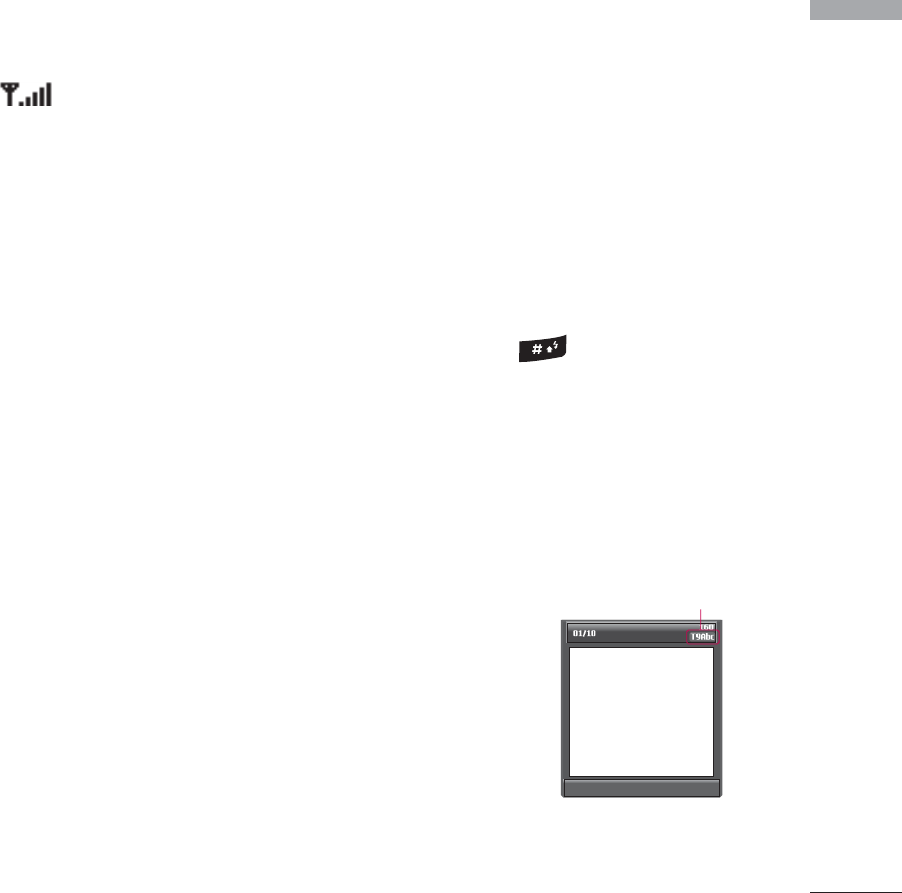
Signal strength
You can check the strength of your signal by
the signal indicator ( ) on the LCD
screen of your phone. Signal strength can
vary, particularly inside buildings. Moving
near to a window may improve reception.
Entering text
You can enter alphanumeric characters by
using the phone’s keypad. For example,
storing names in the phonebook, writing a
message, creating a personal greeting. The
following text input methods are available in
the phone.
T9 mode
This mode lets you enter words with only one
keystroke per letter. Each key on the keypad
has more than one letter. The T9 mode
automatically compares your keystrokes with
an internal dictionary to determine the
correct word, thus requiring far fewer
keystrokes than the traditional ABC mode.
This is sometimes known as predictive text.
ABC mode
This mode lets you enter letters by pressing
the key labelled with the required letter once,
twice, three or four times until the letter is
displayed.
123 mode (Number mode)
Type numbers using one keystroke per
number. To change to 123 mode in a text
entry field, press the key until 123
mode is displayed.
Changing the text input
mode
1. When you are in a
field that allows
characters to be
entered, you will
notice the text
input mode
indicator in the
top right corner of the LCD screen.
General Functions
25
text input mode
Options Insert
)HMX
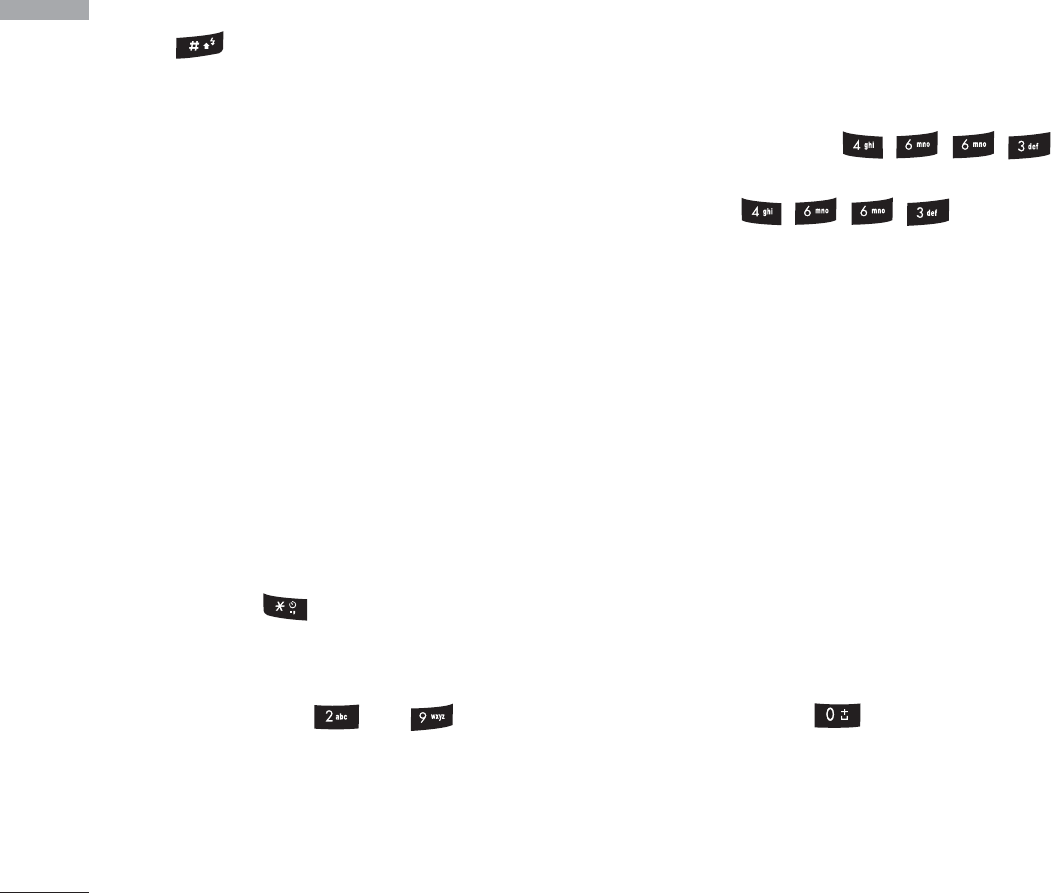
2. Change the text input mode by pressing
You can check the current text
input mode in the top right corner of the
LCD screen.
Using the T9 mode
The T9 predictive text input mode lets you
enter words easily with a minimum number of
key presses. As you press each key, the
phone begins to display the characters that it
thinks you are typing based on the built-in
dictionary.
You can also add new words in the dictionary.
As new words are added, the word changes
to reflect the most likely candidate from the
dictionary. You can turn the T9 mode on or
off, and change the T9 language by holding
down the ( ) key.
1. When you are in the T9 predictive text
input mode, start entering a word by
pressing keys to . Press one
key per letter.
]
The word changes as letters are typed.
Ignore what’s on the screen until the word
is typed completely.
]
If the word is still incorrect after typing
completely, press the down navigation key
once or more to cycle through the other
word options.
Example: Press to
type Good.
Press
[down navigation key] to type Home.
]
If the desired word is missing from the word
choice list, add it using the ABC mode.
]
You can select the language of the T9
mode. Press the left soft key [Option],
then select T9 languages. Select the
desired language of T9 mode. You can also
turn off the T9 mode by selecting T9 off.
The default setting on the phone is T9
enabled mode.
2. Enter the whole word before editing or
deleting any keystrokes.
3. Complete each word with a space by
pressing the key. To delete letters,
press
b
. Press and hold down
b
to
erase entire words.
General Functions
General Functions
26
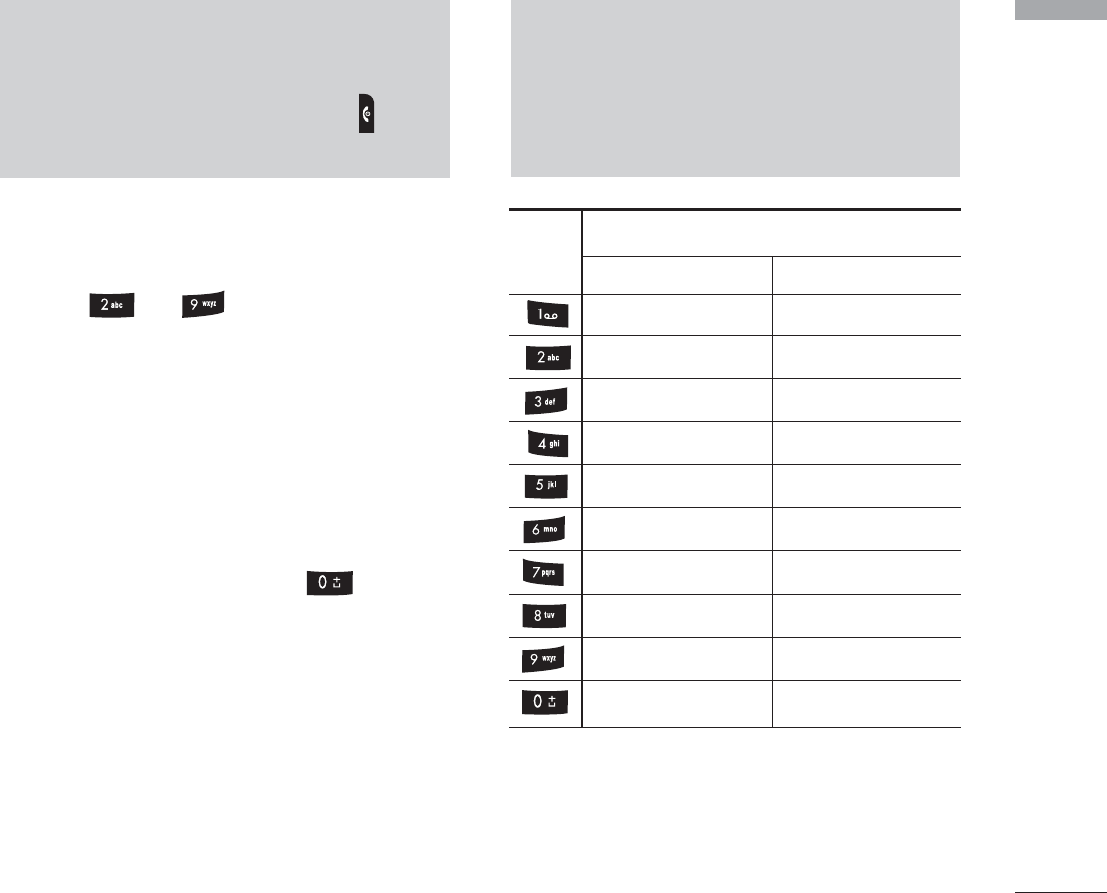
Using the ABC mode
Use the to keys to enter your
text.
1. Press the key labelled with the required
letter:
]
Once for the first letter.
]
Twice for the second letter.
]
And so on.
2. To insert a space, press the key
once. To delete letters, press the
b
key.
Press and hold down the
b
key to clear
the whole display.
Key Characters in the order display
Upper Case Lower Case
. , / ? ! - : ' " 1 . , / ? ! - : ' " 1
A B C 2 a b c 2
D E F 3 d e f 3
G H I 4 g h i 4
J K L 5 j k l 5
M N O 6 m n o 6
P Q R S 7 p q r s 7
T U V 8 t u v 8
W X Y Z 9 w x y z 9
Space 0 Space 0
Note
vRefer to the table below for more
information on the characters available
using the alphanumeric keys.
General Functions
27
Note
vTo exit from the text input mode
without saving your input, press .
The phone goes back to standby mode.

Using the 123 (Number) mode
The 123 mode enables you to enter
numbers in a text message (a telephone
number, for example).
Press the keys corresponding to the required
digits before manually switching back to the
appropriate text entry mode. You can quickly
switch from letters to numbers by pressing
and holding down the ( ) key.
Using the Symbol Mode
Using the Symbol Mode The Symbol Mode
enables you to enter various symbols or
special characters.
To enter a symbol, press the key. Use
the navigation keys to scroll through the
symbols and press the corresponding key
and then press the [OK] key.
Contacts
You can store phone numbers and their
corresponding names in the memory of your
SIM card.
In addition, you can store up to 1000
numbers and names in the phone memory.
The SIM card and phone are both used in the
same way in the Contacts menu.
General Functions
General Functions
28

Your phone offers a set of functions that
allow you to customise the phone. These
functions are arranged in the menus and sub-
menus, accessed via the two soft keys marked
d
and
e
. Each menu and sub-menu
lets you view and alter the settings of a
particular function.
The role of the soft keys vary according to
the current context or the label on the
bottom line of the screen just above each key
indicates its current role.
Selecting Functions and Options
29
Press the right
soft key to access
the available
Contacts.
Press the left soft
key to access the
available menu.

Your phone provides a number of control
functions that you can use during a call. To
access these functions during a call, initially
press the MP3 key to unlock the touch
screen and then press the left soft key
[Options].
During a call
The menu displayed on the handset screen
during a call is different to the default main
menu displayed when in standby mode, and
the options are described below.
Making a second call
You can get a number you wish to dial from
the phonebook to make a second call. Press
the right soft key selecting Contacts. To
save the dialled number into the phonebook
during a call, press the right soft key then
select Add new.
Switching between two calls
To switch between two calls, press the left
soft key then select Swap.
Answering an incoming call
To answer an incoming call when the handset
is ringing, slide open the phone then press
the
a
key. The handset is also able to
warn you of an incoming call while you are
already on a call. A tone sounds in the
earpiece, and the display will show that a
second call is waiting.
This feature, known as Call waiting, is only
available if your network supports it. For
details of how to activate and deactivate it
see Call waiting (Menu 9.6.4)
If Call waiting is activated, you can put the
first call on hold and answer the second, by
pressing or by selecting the left soft key, then
Hold & Answer. You can end the current call
and answer the waiting call by selecting the
Right soft key and then End & Answer.
Rejecting an incoming call
You can reject an incoming call without
answering by simply pressing the key.
During a call, you can reject an incoming call
by pressing the Right soft key [Menu] key
and selecting the Conference/Reject or by
pressing the .
In-call menu
In-call menu
30

Muting the microphone
You can mute the microphone during a call
by pressing the [Options] key then selecting
Mute on. The handset can be unmuted by
selecting Mute off. When the handset is
muted, the caller cannot hear you, but you
can still hear them.
Switching DTMF tones on during
a call
To turn DTMF tones on during a call, press
the left soft key, and then select DTMF on.
DTMF tones can be turned off the same way.
DTMF tones allow your phone to make use of
an automated switchboard.
Multiparty or conference
calls
The multiparty or conference service
provides you with the ability to have a
simultaneous conversation with more than
one caller, if your network operator supports
this feature. A multiparty call can only be set
up when you have one active call and one call
on hold, both calls having been answered.
Once a multiparty call is set up, calls can be
added, disconnected or separated (that is,
removed from the multiparty call but still
connected to you) by the person who set up
the multiparty call. These options are all
available from the In-Call menu. The
maximum callers in a multiparty call are five.
Once started, you are in control of the
multiparty call, and only you can add callers
to the multiparty call.
Making a second call
You can make a second call while currently on
a call. Enter the second number and press the
a
key. When the second call is
connected, the first call is automatically
placed on hold. You can swap between calls
by pressing the left soft key then selecting
Swap.
Setting up a conference call
Place one call on hold and while the active call
is on, press the left soft key and then select
the Conference/Join all.
In-call menu
31

Putting a conference call on hold
Press the left soft key, then select the
Conference/Hold all.
Activate the conference call on
hold
Press the left soft key, then select the
Conference/Join all.
Adding calls to the conference call
To add a call to an existing conference call,
press the left soft key, then select the
Conference/Join all.
Displaying callers in a conference
call
To scroll through the numbers of the callers
who make up a conference call on the
handset screen, use the up/down navigation
keys.
Taking a private call during a
conference call
To have a private call with one caller from a
conference call, display the number of the
caller you wish to talk to on the screen, then
press the left soft key. Select the
Conference/Private to put all the other
callers on hold.
Ending a conference call
The currently displayed caller from a
conference call can be disconnected by
pressing the key. To end a conference
call, press the left soft key, then select the
Conference/End multiparty.
After pressing the left soft key, selecting all
will end all the active and onhold calls.
In-call menu
In-call menu
32
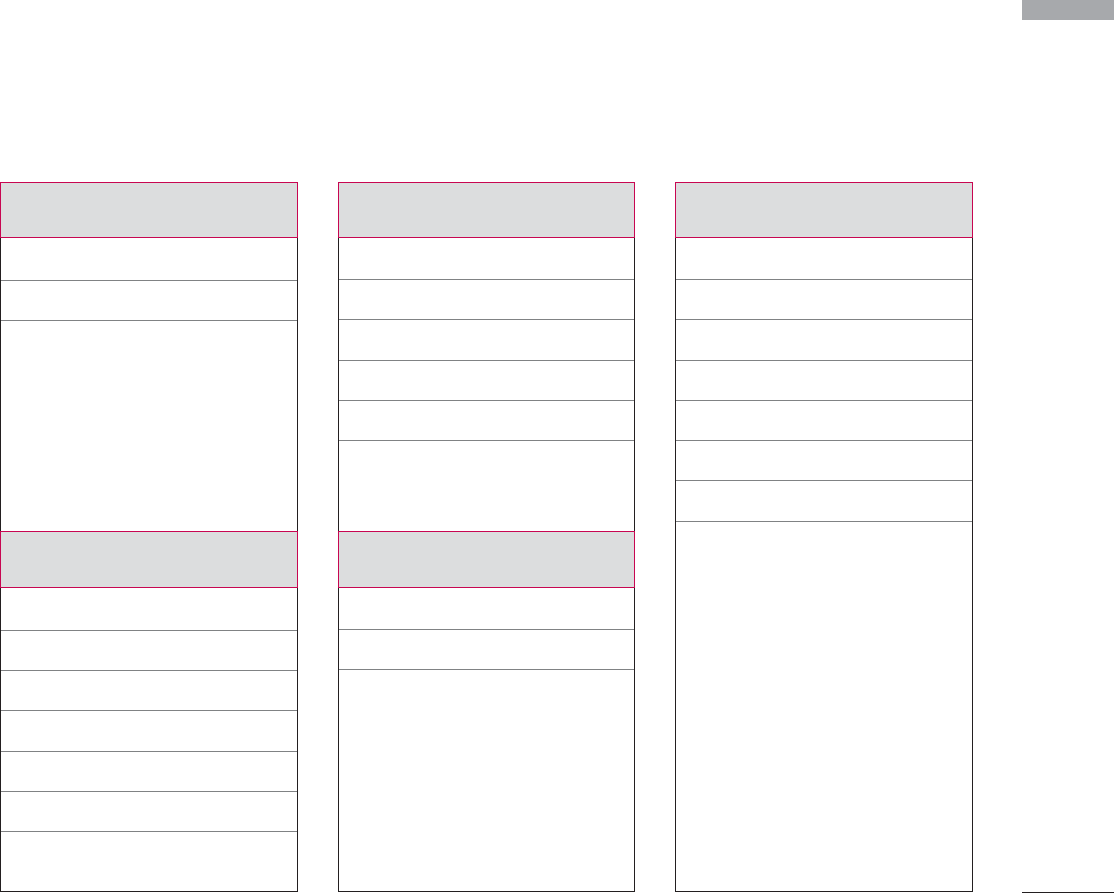
The following illustration shows the available menu structure and indicates the:
]
Number assigned to each menu option.
33
Menu Tree
Menu Tree
5.1 New message
5.2 Inbox
5.3 Drafts
5.4 Outbox
5.5 Listen to voice mail
5.6 Info message
5.7 Templates
5.8 Settings
3.1 Favourites
3.2 Alarm clock
3.3Calculator
3.4 Unit converter
3.5 World time
3.6 SIM-Menu
4.1 Contacts
4.2 Calendar
4.3 Memo
1.X.1 Activate
1.X.2 Personalise
1.X.3 Rename
2.
1 Missed calls
2.
2 Received calls
2.
3 Dialled calls
2.
4 All calls
2.
5 Delete recent calls
2.
6 Call charges
2.
7 GPRS information
1.
Profiles
3. Tools 5. Messages
4. Organiser2. Call register
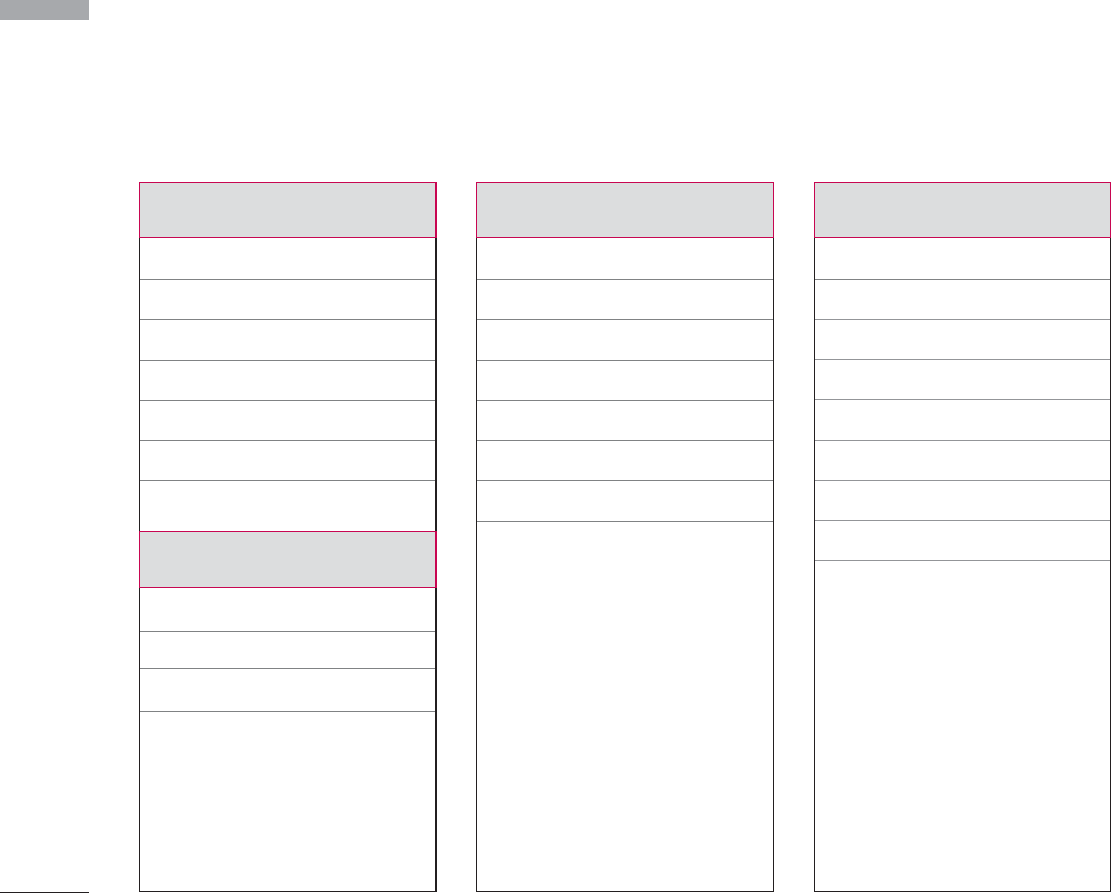
Menu Tree
Menu Tree
34
9.1 Date & time
9.2 Display
9.3 Power saving
9.4 Language
9.5 Connectivity
9.6 Calling
9.7 Security
9.8 Memory status
9.9 Reset settings
8.1 Games & apps
8.2 Videos
8.3 Photos
8.4 Music
8.5 Text
8.6 Images
8.7 Sounds
8.8 Others
6.1 Camera
6.2 Video camera
6.3 Voice recorder
6.4 MP3
6.5 Photo album
6.6 Video album
6.7 Settings
7.
1 Home
7.
2 Bookmarks
7.
3 Go to URL
7.
4 Settings
6. Multimedia 8. My stuff 9. Settings
7. Browser

In Profiles, you can adjust and customise the
phone tones for different events,
environments, or caller groups.
There are five preset profiles: General,
Silent, Vibrate only, Loud and Headset.
Each profile can be personalised. Press the
left soft key [Menu] and select Profiles using
up/down navigation keys.
Activate (Menu 1.X.1)
1. A list of profiles is displayed.
2. In the Profiles list, scroll to the profile you
want to activate and press the left soft key
d
OK key.
3. Then, select Activate.
Personalise (Menu 1.X.2)
Scroll to the desired profile in the Profile list.
After pressing the left soft key
d
or the
OK key, select Personalise. The profile
setting option opens. Set the option as
required.
]
Call alert type: Set the alert type for
incoming calls.
]
Ring tone: Select the desired ring tone
from the list.
]
Ring volume: Set the volume of the ringing
tone.
]
Message alert type: Set the alert type for
messages.
]
Message tone: Select the alert tone for
messages.
]
Keypad tone: Select the desired keypad
tone.
]
Keypad volume: Set the volume of keypad
tone.
]
Slide tone: Allows you to set the slide
tone.
]
Effect sound volume: Set the volume of
effect sound.
]
Power on/off volume: Set the volume of
the ringing tone when switching the phone
on/off.
Rename (Menu 1.X.3)
You can rename a profile and give it any name
you choose to.
Profiles
Profiles
35

1. To change the name of a profile, scroll to
the profile in the profile list and after
pressing the left soft key
d
or the OK
key, select Rename.
2. Key in the desired name and press the OK
key or the left soft key
d
[OK].
Note
vVibrate only, Silent and Headset profiles
cannot be renamed.
Profiles
Profiles
36

You can check the record of missed, received,
and dialled calls only if the network supports
the Calling Line Identification (CLI) within the
service area.
The number and name (if available) are
displayed together with the date and time at
which the call was made. You can also view call
times.
Missed calls Menu 2.1
This option lets you view the last 10
unanswered calls. You can also:
]
View the number if available and call it, or
save it in the Address Book
]
Enter a new name for the number and save
both in the Address Book
]
Send a message to this number
]
Delete the call from the list
Received calls Menu 2.2
This option lets you view the last 10 incoming
calls. You can also:
]
View the number if available and call it or
save it in the Address Book
]
Enter new name for the number and save
both in the Address Book
]
Send a message to this number
]
Delete the call from the list
Dialled calls Menu 2.3
This option lets you view the last 20 outgoing
calls (called or attempted).
You can also:
]
View the number if available and call it or
save it in the Address Book
]
Enter new name for the number and save
both in the Address Book
]
Send a message to this number
]
Delete the call from the list
Call register
Call register
37

All calls Menu 2.4
You can view all lists of outgoing or incoming
calls.
Delete recent calls Menu 2.5
Allows you to delete Missed calls and
Received calls lists. You can delete Dialled
calls and All calls lists at one time.
Call charges Menu 2.6
Call duration (Menu 2.6.1)
Allows you to view the duration of your
incoming and outgoing calls. You can also
reset the call times.
The following timers are available:
]
Last call: Length of the last call.
]
All calls: Total length of all calls made and
incoming calls since the timer was last
reset.
]
Received calls: Length of the incoming
calls.
]
Dialled calls: Length of the outgoing calls.
]
Reset all: Allows you to reset the timers of
all calls by pressing the left soft key
d
[Yes].
Call costs (Menu 2.6.2)
Allows you to check the cost of your last call,
all calls, remaining and reset the cost. To
reset the cost, you need to know your PIN2
code.
Settings (Menu 2.6.3)
(SIM Dependent)
]
Set tariff: You can set the currency type
and the unit price. Contact your service
providers to obtain charging unit prices.
To select the currency or unit in this menu,
you need the PIN2 code.
]
Set credit: This network service allows you
to limit the cost of your calls by selected
charging units. If you select Read, the
number of remaining unit is shown. If you
select Change, you can change your
change limit.
Call register
Call register
38

]
Auto display: This network service allows
you to automatically see the cost of your
last calls. If set to On, you can see the last
cost when the call is released.
GPRS information Menu 2.7
You can check the amount of data
transferred over the network through the
GPRS information option. In addition, you
can also view how much time you are online.
Call duration (Menu 2.7.1)
You can check the duration of Last call and
All calls. You can also reset the call timers.
Data volume (Menu 2.7.2)
You can check The Sent, Received or All
data volumes and Reset all.
Call register
39

Favourites Menu 3.1
This option allows you to add your own
favourites to the list already provided. Once
you create your own menu, you can access
the desired function quickly in the idle screen
by pressing the up navigation key.
Alarm clock Menu 3.2
You can set up to 5 alarm clocks to go off at
a specified time.
1. Select On and enter the alarm time you
want.
2. Select the repeat period: Once, Mon Fri,
Mon Sat, Everyday.
3. Select the alarm tone you want and press
d
[OK].
4. Edit the alarm name and press
d
[OK].
Calculator Menu 3.3
This contains the standard functions such as
+, _, x, ÷ : Addition, Subtraction,
Multiplication, and Division.
Furthermore, you can use the various
function of calculator such as +/_, sin, cos,
tan, log, IN, exp, sqrt.
1. Input the numbers by pressing numeric
keys.
2. Use a navigation key to select a sign for
calculation.
3. Then input the numbers.
4. Press
h
key to view the result.
5. To input the decimal number, press
key. If youpress key, you can enter
( ).
6. To end Calculator, press the right soft key
e
[Back].
Note
vThe menu of SMS, MMS, Games &
apps, Connectivity, Alarm clock, MP3
and Camera is already provided in your
own favourites.
Tools
Tools
40

Unit converter Menu 3.4
This converts any measurement into a unit
you want. There are 9 types that can be
converted into units:
Currency, Area, Length, Weight,
Temperature, Volume, Velocity, Shoes and
Clothes.
1. You can select one of nine unit types by
pressing
d
[OK] key.
2. Select the unit you want to convert by
pressing
i
and
j
. It’s impossible to
input “-” symbol inunit converter.
3. Select the standard value by using
k
,
l
.
World time Menu 3.5
You can check the current time of Greenwich
Mean Time (GMT) and major cities around
the world, using the left/right navigation
keys.
The screen shows the city name, current date
and time.
To select the time zone in which you are
located, proceed as follows:
1. Select the city corresponding to your time
zone by pressing the left/right navigation
keys one or more times. The local date and
time are displayed.
2. If you want to change the time display in
standby mode to the selected time, press
the left soft key and select Set.
SIM-Menu MENU 3.6
This menu depends on SIM and the network
services.
Note
]
In case the SIM card support
SAT(i.e. SIM Application Toolkit)
services, this menu will be the
operator specific service name
stored on the SIM card.
]
In case the SIM card does not
support SAT services, this menu
will be Profiles.
Tools
41

Contacts Menu 4.1
Search contacts (Menu 4.1.1)
1. Select Search by pressing the right soft
key
e
[Contacts] or [OK].
2. Enter the name that you want to search.
3. If you want to edit, delete or copy an
entry, select the left soft key
d
[Options]. The following menuwill be
displayed.
]
Edit: You can edit the name, number,
group, character and picture by using the
navigation key.
]
Write messages: After you have found the
number you want, you can send a
text/multimedia message to the selected
number.
]
Send via Bluetooth: You can send the
data of phone book to devices which is
compatible with Bluetooth through
Bluetooth.
]
Copy to handset: You can copy an entry
from SIM to phone or from phone to SIM.
]
Assign speed dial: You can assign the
entry as a speed dial.
]
View caller groups: For further details see
(Menu 4.1.3).
]
Delete: You can delete an entry.
Add new (Menu 4.1.2)
You can add a phonebook entry by using this
function. Phone memory capacity is 1000
Note
vTo use the Photo Caller ID feature,
contacts must exist within the Phone
Book and photos must be taken in
72x72 resolution. For more
information about associating a photo
to a contact please refer to the Camera
section.
Note
vInstant searching is available by
inputting the initial letter of the name
or number you want to search.
Organiser
Organiser
42

entries. SIM card memory capacity depends
on the mobile service provider. You can also
save 40 characters of name in The Phone
memory, and save characters in the SIM card.
The number of characters is a SIM dependent
feature.
1. Select Add new by pressing the left soft
key
d
[OK] or [OK].
2. Select the memory you want to save: SIM
or Phone. If you set to Phone, you need to
select which number you want as a main
number.
a. Press
d
[OK] to input a name.
b. Press
d
[Save], then you can input a
number.
c. You can set a group for the entry by
pressing
k
,
l
.
d. You can set a picture for the entry by
pressing
k
,
l
.
Caller groups (Menu 4.1.3)
You can add up to 20 members per group,
with up to a maximum of 7 groups in total.
]
Member list: Shows the group members
you have selected.
]
Group ring tone: Allows you to specify
ring tone for the group members’ call.
]
Group icon: Allows you to select the icon
dependent on Group.
]
Add member: You can add group
members. Each group should not exceed
20 members.
]
Remove member: You can remove the
member from the Group member list. But
the name and the number will remain in the
phonebook.
]
Rename: You can change a group name.
]
Remove all: Allows you to delete all the
members in the group.
Note
vMaximum stored name and number
length depends on SIM-card type.
Organiser
43

Speed dial (Menu 4.1.4)
Assign contacts to any of the keys to
.
You can then call that contact by pressing
the corresponding number key.
1. Open the phonebook first by pressing the
right soft key
e
[Contacts] in standby
mode.
2. Scroll to Speed dial, then press the left
soft key
d
[OK].
3. If you want to add speed dial, select
(empty). Then, you can search the name in
phonebook.
4. After assigning the number as speed dial,
you can change and delete the entry. You
can also make a call or send a message to
this number.
Own number (Menu 4.1.5)
(Sim dependent)
You can save and check your own number in
SIM card.
My business card (Menu 4.1.6)
This option allows you to create your own
business card featuring Name and a mobile
phone number. To create a new business
card, press the left soft key
d
[Add] and
enter the information into the fields.
Settings (Menu 4.1.7)
1. Press the right soft
e
[Contacts] in
standby mode.
2. Scroll to Settings, then press the left soft
key
d
[OK].
]
Default memory
Scroll to highlight Default memory, and
then press the left soft key
d
[OK].
- If you select Always ask, when adding an
entry, the phone will ask where to store
it.
- If you select SIM or Handset, the phone
will store an entry to the SIM or phone.
]
View options
Scroll to highlight View options, and then
press the left soft key
d
[OK].
Organiser
Organiser
44

- Name only: Set the phonebook list by
displaying the name only.
- Name & number: Set the phonebook
list by displaying the name and number.
- With pictures: Set the phonebook list
with the information and picture of
contact.
]
Copy/Move all
You can copy/move entries from SIM card
memory to Phone memory and vice versa.
1. Open the Phonebook first by pressing the
right soft key
e
[Contacts] in standby
mode.
2. Scroll to Copy/Move all, and then press
the left soft key
d
[OK] to enter this
menu.
•SIM to Handset: You can copy/move
the entries from SIM Card to Phone
memory.
•Handset to SIM: You can copy/move
the entries from Phone memory to SIM
Card.
]
Memory in use: This feature allows you to
see how many entries are in use, or free in
your phonebook.
]
Clear contacts
You can delete all the entries in the SIM
and Phone. This function requires the
Security code.
1. Scroll to highlight Clear contacts, and then
press the left soft key
d
[OK].
2. Highlight the memory you wish to erase,
and then press the left soft key
d
[OK].
3. Enter the security code and press the left
soft key
d
[OK] or the right soft key
e
[Back].
]
Service dial number
Use this function to access a particular list
of services provided by your network
operator (if supported by the SIM card).
Organiser
45
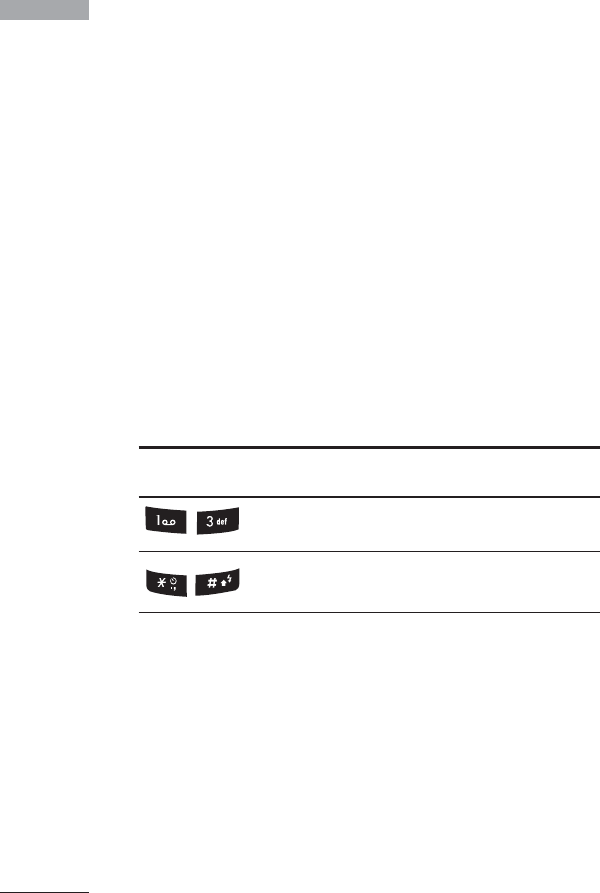
Calendar Menu 4.2
When you enter this menu a calendar will be
displayed. The month and year are shown at
the top of the screen. Whenever you the
change the date under the Settings menu,
the calender will update automatically. The
current date will be highlighted in green and
any schedule or memos will be indicated with
a red triangle at the top left hand corner of
the corresponding square. An audible alarm
can be set for memo’s and reminders.
To change the day, month and year.
Key Description Key Description
Yearly
ij
Weekly
Monthly
kl
Daily
In calendar mode, press the left soft key
d
[Options] as follows;
Add new(Menu 4.2.1)
Allows you to add a new schedule and memo
for the chosen day. You can store up to 20
notes. Input the subject and then press left
soft key
d
[OK]. You enter the
appropriate information in the following
section; Time, Repeat and Alarm.
View daily schedules (Menu 4.2.2)
View all schedules and memo for the chosen
day. Use
i
,
j
to browse through the
note lists. If you set the alarm for a note, the
alarm icon is displayed.
If you want to view the note in detail, press
the left soft key
d
[OK]. Press the left soft
key
d
[Options] to delete or edit the note
you have selected.
Delete past (Menu 4.2.3)
You can delete the past schedule that you
have already been notified of.
Delete all (Menu 4.2.4)
You can delete all the notes.
Organiser
Organiser
46

Go to date(Menu 4.2.5)
You can go the chosen date directly.
Set alarm tone (Menu 4.2.6)
You can set the alarm tone of each chosen
date.
Memo Menu 4.3
1. Select the Memo by pressing the left soft
key
d
[OK].
2. If the entry is empty, press the left soft key
d
[Write].
3. Input the memo and then press the left
soft key
d
[OK].
Organiser
47
Note
vIf you want to change the text input
mode, press the in order.

New message Menu 5.1
This menu includes functions related to SMS
(Short Message Service), MMS (Multimedia
Message Service), voice mail, as well as the
network’s service messages.
Write text message (Menu 5.1.1)
You can write and edit text message,
checking the number of message pages.
1. Enter the New messages menu by
pressing the left soft key
d
[OK].
2. If you want to write a new message, select
Write text message.
3. To make text input easier, use T9.
4. Press [Insert] to attach the following;
Insert
]
Images: You can insert the Default
graphics or graphics in My pictures that
are available for short messages.
]
Sounds: You can insert sounds that are
available for short messages.
]
Text templates: You can use Text
templates already set in the phone.
]
Contacts: You can add phone numbers or
e-mail addresses in the address book.
]
Symbol: You can add special characters.
]
My business card: You can add your
Business card to the message.
5. After you complete the message, to select
the required option, press the left soft key
d
[Options].
Options
]
Send: Sends text messages.
1. Enter numbers of recipient.
2. Press
j
key to add more recipients.
3. You can add phone numbers in the
address book.
4. Once the numbers have been entered,
press the left soft key
d
to send the
message. All messages will automatically be
saved in the outbox slide, even after a
sending failure.
]
Save to drafts: Stores messages in the
Drafts slide.
]
Font & Alignment: You can select the
Size and Style of font, and the Alignment
of text.
Messages
Messages
48

]
Colour: You can also set the Colour of the
text (foreground) and the background.
]
Add T9 dictionary: You can add your own
words. This menu will only be shown when
the edit mode has been set to
T9ABC/T9Abc/T9abc.
]
T9 languages: Select the desired language
for T9 input mode. You can also deactivate
the T9 input mode by selecting ‘T9 off ’.
]
Exit: If you press Exit whilst writing a
message, you will be taken back to the
message menu. Also the written message
will not have been saved.
Write multimedia message
(Menu 5.1.2)
A multimedia message can contain text,
images, and/or sound clips. This feature can
be used only if it is supported by your
network operator or service provider. Only
devices that offer compatible multimedia
message or e-mail features can receive and
send multimedia messages.
1. Enter the New message menu by pressing
the left soft key
d
[OK].
2. If you want to write a new message, select
Write multimedia message.
3. You can create a new message or choose
one of the multimedia message templates
already made.
4. Press Insert to add Image, Sound,
Contacts, Symbol, New photo, New sound,
Text templates, My business card.
Maximum available file size, that can be
inserted to MMS-message, is 100 kb.
Note
vThis phone supports EMS release 5, so
is available to send colour pictures,
sounds, text styles, etc.. If the other
parties handsets do not support such
options, the pictures, sounds or texts
sent may not be displayed correctly on
their phones.
Messages
49

Options
]
Send: You can send multimedia messages
to multiple recipients, as well as save it to
send at a later time.
]
Preview: You can preview multimedia
messages you have created.
]
Save: You can save multimedia messages
To drafts or As template.
]
Edit subject: Allows you to modify the
multimedia message you have chosen.
]
Add slide: You can add a slide before or
after current slide.
]
Move to slide: You can move to the
previous or the next slide.
]
Delete slide: You can delete current
folders.
]
Set slide format
- Set timer: You can set a timer for slide,
text, picture and sound.
- Swap text and picture: You can switch
the position of picture and text of the
message.
]
Remove media: You can remove a picture
or sound in the slide. This option can be
shown only when any media file has been
added.
]
Add T9 dictionary: You can add your own
words. This menu will only be shown when
the edit mode has been set to
T9ABC/T9Abc/T9abc.
]
T9 languages: Select the desired language
for T9 input mode. You can also deactivate
T9 input mode by selecting ‘T9 off ’.
]
Exit: Will take you back to the Message
menu.
Note
vAll messages will be automatically saved
in the outbox slide, even after a sending
failure.
Messages
Messages
50
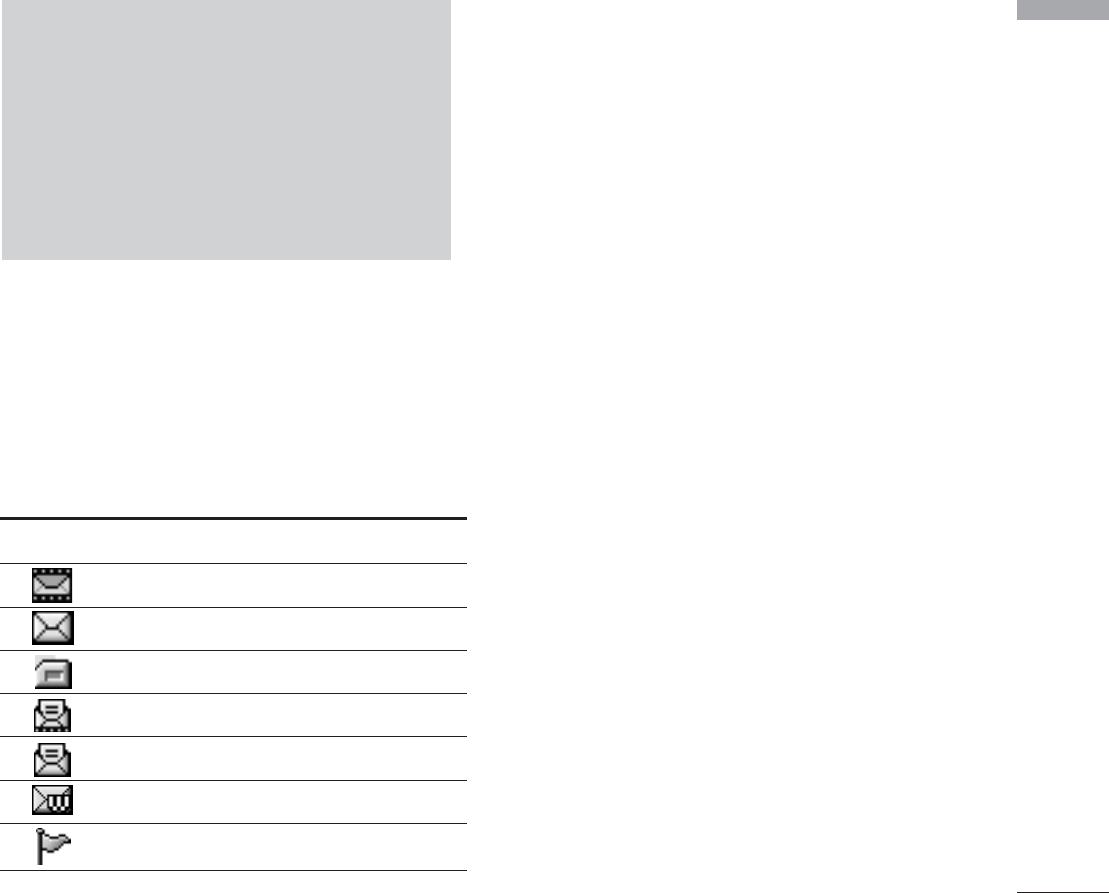
Inbox Menu 5.2
You will be alerted when you have received a
message. They will be stored in the Inbox. In
the Inbox, you can identify each message by
icons. For detail, see the icon directive.
Icon Icon directive
Multimedia message
Short message
SIM message
Read multimedia message
Read text message
Push message
Notified multimedia message
If the phone shows ‘No space for SIM
message’, you only have to delete the SIM
messages from the Inbox. If the phone displays
‘No space for message’, you will then need to
delete messages, media or applications to free
up space.
* SIM message
SIM message means that the message is
exceptionally stored in the SIM card.
When you are notified that you have received
a multimedia message, you have to wait for the
message to be downloaded before you can
view it.
To read a message, select one of the messages
by pressing the left soft key
d
[Options].
]
View: You can view the received messages.
]
Reply: You can reply to the sender.
]
Forward: You can forward the selected
message to another party.
]
Delete: You can delete the current
message.
]
Return call: You can call back the sender.
Note
vWhen creating a multimedia message, if
you upload a picture (50K) you may
find that whilst the picture is loading
you will not be able to carry out any
other actions until the picture has
competed loading.
Messages
51
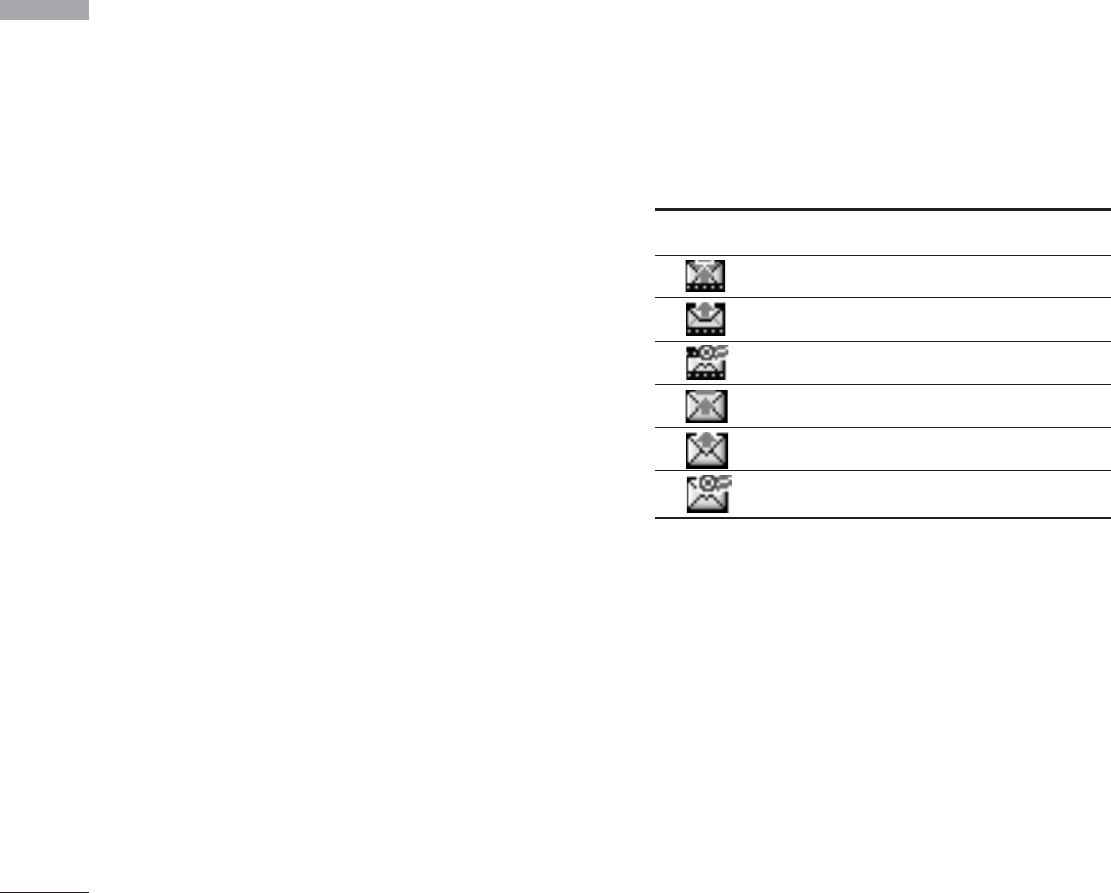
]
Information: You can view information
about received messages; Sender’s
address, Subject (only for Multimedia
message), Message date & time, Message
type, Message size.
]
Delete all: You can delete all messages.
Drafts Menu 5.3
Using this menu, you can preset up to five
multimedia messages that you use most
frequently. This menu shows the preset
multimedia message list.
The following options are available.
]
View: You can see the multimedia
messages.
]
Edit: Allows you to modify the chosen
message.
]
Delete: Deletes the message you choose.
]
Information: To view the information of
the message.
]
Delete all: Deletes all of the messages in
the slide.
Outbox Menu 5.4
This menu allows you to view the messages
which you have sent, those that are currently
sending or messages that have failed sending
previously.
Icon Icon directive
MMS Unsent
MMS sent
MMS delivery confirmed
SMS unsent
SMS sent
SMS delivery confirmed
]
View: You can view the message.
]
Forward: You can forward the selected
message to another party.
]
Delete: You can delete the message.
]
Information: You can check the
information of each message.
]
Delete all: You can delete all the messages
in the outbox.
Messages
Messages
52

Listen to voice mail Menu 5.5
Once this menu has been selected, simply
press the left soft key
d
[OK] to listen to
voice mail. You can also hold down the
key in standby mode to listen to voice mail.
Info message Menu 5.6
(Dependent to network and
subscription)
Info service messages are text messages
delivered by the network to your handset.
They provide general information such as
weather reports, traffic news, taxis,
pharmacies, and stock prices. When you
receive an info service message, you will see a
popup message show you that or the info
service message is directly displayed. To view
the message again follow the sequence
shown below;
Read (Menu 5.6.1)
1. When you have received an info service
message and select Read to view the
message, it will be displayed on the screen.
You can read another message by scrolling
i
,
j
or
d
[OK].
2. The message will be shown until another
message is selected.
Note
vWhen you receive a voice mail, your
phone will display an icon and you will
hear an alert. Please check with your
network provider for details of their
service in order to configure the
handset correctly.
Messages
53

Topics (Menu 5.6.2)
(Dependent to network and
subscription)
]
Add new: You can add Info service
message numbers in the Phone memory
with its nickname.
]
View list: You can see Info service message
numbers which you have added. If you
press
d
[Options], you can edit and
delete info message categories which you
have added.
]
Active list: You can select info service
message numbers in the active list. if you
activate an info service number, you can
receive messages sent from the number.
Templates Menu 5.7
Tex t templat es (Menu 5.7.1)
You have 6 text templates as below;
• Please call me back.
• I’m late. I will be there at
•Where are you now?
•I am on the way.
• Top urgent. Please contact.
• I love you.
Multimedia templates (Menu 5.7.2)
After you have saved a new template, you can
use the following options.
]
View: You can see multimedia templates.
]
Delete: You can delete multimedia
templates.
]
Add new: Allows you to add new
multimedia templates.
]
Write messages: You can write and send
multimedia messages.
Messages
Messages
54

]
Edit: You can edit multimedia templates.
]
Delete all: Allows you to delete all
multimedia messages.
Settings Menu 5.8
Text message (Menu 5.8.1)
]
Message types:
Text, Voice, Fax, Natl. paging, X.400,
Email, ERMES
Usually, the type of message is set to Text.
You can convert your text into alternative
formats. Contact your service provider for
the availability of this function.
]
Validity period: This network service
allows you to set how long your text
messages will be stored at the message
centre.
]
Delivery report: If you set to Yes, you can
check whether your message is sent
successfully.
]
Reply charging: When a message is sent, it
allows the recipients to reply and charge
the cost of the reply to your telephone bill.
]
SMS centre: If you want to send the text
message, you can receive the address of
SMS centre through this menu.
Mulitimedia message (Menu 5.8.2)
]
Priority: You can set the priority of the
message you choose.
]
Validity period: This network service
allows you to set how long your text
messages will be stored at the message
centre.
]
Subject: You can enter multimedia
messages subject when this menu is on.
]
Delivery report: If it is set to Yes in this
menu, you can check whether your
message is sent successfully.
Messages
55

]
Auto retrieve: If you select On, you
receive multimedia messages
automatically. If you select Off, you receive
only notification message in the inbox and
then you can check this notification. If you
select Home network only, you receive
multimedia messages depends on
Homenetwork.
]
Network settings: If you select multimedia
message server, you can set URL for
multimedia message server.
]
Permitted message types
Personal: Personal message.
Advertisements: Commercial message.
Information: Necessary information.
Voice mailbox number (Menu 5.8.4)
You can receive voicemail if your network
service provider supports this feature. When
a new voicemail has arrived, the symbol will
be displayed on the screen. Please check with
your network service provider for details of
their service in order to configure the phone
accordingly.
]
Home: You can listen to voice mails by
selecting Home.
]
Roaming: Even when you are abroad, you
can listen to voice mails if a roaming service
is supported.
Messages
Messages
56

Info message (Menu 5.8.5)
]
Receive
Yes: If you select this menu, your phone
will receive Info service messages.
No: If you select this menu, your phone
will not receive Info service messages any
more.
]
Alert
Yes: Your phone will beep when you have
received Info service message numbers.
No: Your phone will not beep even though
you have received info service messages.
]
Languages
You can select the language you want by
pressing [On/Off]. Then, the info service
message will be shown in the language that
you selected.
Push message (Menu 5.8.6)
You can set the option whether you will
receive the message or not.
Messages
57

Camera Menu 6.1
This application enables you to take a still
picture. You can take a picture in your
desired size, and use it for the contacts
photo, home screen and other more general
purposes. Once taken, a still image can be
sent via Multimedia msg.
Press the left soft key
d
to display the
following popup menu items.
]
Brightness: Determines the brightness.
]
Size: Determines the size of an image.
]
Timer: Determines the delay time.
]
Quality: Determines the quality of an
image.
]
White Balance : Allows you to change the
settings according to the environment.
]
Album: Shows the still images taken.
]
Exit: To exit the Camera.
]
Mode: Determines whether to take a
single , multishot or frame shot photo.
]
Effect: Determines the special effect to the
picture.
]
Flash: Determines the flash operation.
]
Zoom: Determines the zoom rate.
Note
vFrame shots are only available with the
pixel resolution set to 176 x 220.
vMulti shots are only available when the
pixel resolution is set to 320 x 240 or
640 x 480.
vTo use the Photo Caller ID feature, you
must take photos you wish to associate
with your contacts in 72x72 resolution.
vOnce the photo has been taken and
saved, go to Contacts and select the
contact you wish to associate the
photo to or select Add new to create a
new contact(please note that a photo
can only be associated with a contact
stored in the phone's memory and not
on the SIM).
vSelect
Edit
. Unless you wish to edit the
name, press OK and then use the
navigation keys to highlight the picture
tab.
Multimedia
Multimedia
58

Video camera Menu 6.2
This application enables you to record a
video clip. You can play and watch a saved
video file while using this function.
Press the left soft key
d
to display the
following popup menu items.
]
Brightness: Determines the brightness.
]
Size: Determines the size of an image.
]
Timer: Determines the delay time.
]
Quality: Determines the quality of a video
clip.
]
White Balance : Allows you to change the
settings according to the environment.
]
Record Time: Determines the recording
time.
]
Exit: To exit the Video camera.
]
Effect: Determines the special effect to the
video clip.
]
Flash: Determines the flash operation.
]
Zoom: Determines the zoom rate.
Voice recorder Menu 6.3
With the voice memo feature you can record
up to 20 voice messages and each memo can
be up to 20 seconds long.
Record (Menu 6.3.1)
You can record a voice memo in the Voice
recorder menu.
Note
vUse the
k
,
l
keys to scroll through
the photos (please note that only
pictures taken in 72l72 resolution
will be listed here).
vOnce you have selected the photo you
wish to use press the left soft key to
save this in the contacts profile.
vThe photo will be shown when this
particular contact calls you (as long as
the contact does not have their
telephone number set to hidden).
Multimedia
59

1. Once recording has started, the message
Recording and the remaining time is
displayed.
2. If you want to finish recording, press the
left soft key
d
[Save].
3. Key in Voice memo title, press the left soft
key
d
[OK].
View list (Menu 6.3.2)
The list of voice memos are displayed. You
can playback and delete the recorded voice
memo. The following [Options] menus are
available
MP3 Menu 6.4
The has an integrated MP3 player
built-in. You can enjoy listening to MP3
music files on your phone memory using a
compatible headset or via the internal
loudspeaker.
The music player supports:
• MPEG-1 Layer III, MPEG-2 Layer III, MPEG-
2.5 Layer III Sampling frequency up from
8KHz to 48KHz. Bit rate up to 320Kbps,
stereo.
• AAC: ADIF, ADTS formats (Sampling
frequency from 8KHz to 48KHz)
• AAC+: V1 : (Bit rate 16-128Kbps)
V2 : (Bit rate 16-48Kbps)
(Sampling frequency from 8KHz
to 48KHz)
• MP4, M4A: Sampling frequency up from
8KHz to 48KHz, Bit rate up to 320Kbps,
stereo.
• WMA: Sampling frequency up from 8KHz
to 48KHz, Bit rate up to 320Kbps, stereo.
Note
vBecause of the small dimension of the
speaker, in some cases the audio could
be distorted, especially at maximum
volume and when there are lots of bass
sounds. Therefore, we recommend you
to use the stereo headset in order to
appreciate the high quality of your
music.
Multimedia
Multimedia
60

You can transfer MP3 files from a compatible
PC to the memory in your phone using the
Mass Storage. When you connect the phone
to a PC using the USB cable(supplied in the
same package), this will be displayed as a
removable disk through Windows Explorer. If
you are using Win98 SE, you will have to
install the Mass storage driver for Windows
98 on CD-ROM.
This menu allows you to view the whole play
list. You can move through the tracks by
pressing the navigation key. In addition, once
you have selected the track, you can delete
the file or view its information via the options
menu.
1. Go to MP3 player : Move to MP3 player.
Press the left soft key
d
[Options] to
access the following menus.
]
View play list: You can view the play list on
listening to the music.
]
Area repeat: The special area part of the
current music is repeated when you select
ON of the menu.
]
Set as ring tone: This menu allows to set
the MP3 file as a ring tone. You can also
set it as a ring tone in Profile.
]
Setting
- Equalizer
This menu helps you to adjust to a
variety of environments when listening to
music. This phone supports four preset
menus. When you enter this menu, you
can view current value of equalizer.
Note
vYou should copy MP3 to my
media\Music folder. If you copy to
another folder, you will not be able to
view the MP3 files.
vThe PC should run Windows 98 SE,
Windows ME, Windows 2000,
Windows XP operating system.
Note
v doesn't support the variable
rate of MP3 and AAC file. Therefore,
you can't change the file from VBR MP3
format to AAC.
Multimedia
61

Multimedia
Multimedia
62
- Playmode
This menu allows to set the play mode.
- Set shuffle
You can listen to your MP3 music
randomly.
- Visual effect
You can select the visual effect menus:
Rainbow, Basic and Blue. This menu
allows to change the backgroud of main
LCD and sub LCD on playing MP3 file.
2. Delete: Deletes the file selected.
3. View details: To view the information of
the file you selected.
4. Delete all: Deletes all of the files.
Photo album Menu 6.5
You can view and send a picture. In addition,
you can set the picture as a wallpaper.
]
Multi view: You can view the maximum of 9
thumbnails in a screen.
]
Send via Bluetooth: You can send a
picture by Bluetooth.
]
Write multimedia message: You can write
and edit multimedia messages, checking
message size.
]
Set as wallpaper: You can set a picture as
a wallpaper.
]
Slide show: You can view the pictures in a
slide show.
]
Delete: You can delete a picture.
]
Edit title: You can edit the title of picture.
]
Information: Displays information about
the saved picture.
Note
vThe Photo Album will only display
pictures taken by the handsets camera.
Note
vMusic is copyright protected in
international treaties and national
copyright laws. It may be necessary to
obtain permission or a license to
reproduce or copy music. In some
countries national law prohibits private
copying of copyrighted material. Please
check the national legislation of the
applicable country concerning the use
of such material.

Video album Menu 6.6
You can view videos which have been saved in
the memory.
]
Play: You can play the video file when
pressing the OK key or selecting Play menu
of the Options menu.
]
Send via Bluetooth: Send the selected file
to another device via Bluetooth.
]
Rename: Change the file name of selected
file.
]
Delete: Delete a file.
]
Delete all: Delete all files in the list
]
Information: Show the file information.
Settings Menu 6.7
Camera(Menu 6.7.1)
]
Auto save: If you set this feature to On,
the images will be saved automatically
without displaying the menu bar to save.
]
Delete all photos: You can delete all the
photos which have been saved in the
memory.
Video camera (Menu 6.7.2)
]
Delete all videos: Allows you to delete all
the videos which have been saved in the
memory.
Multimedia
63
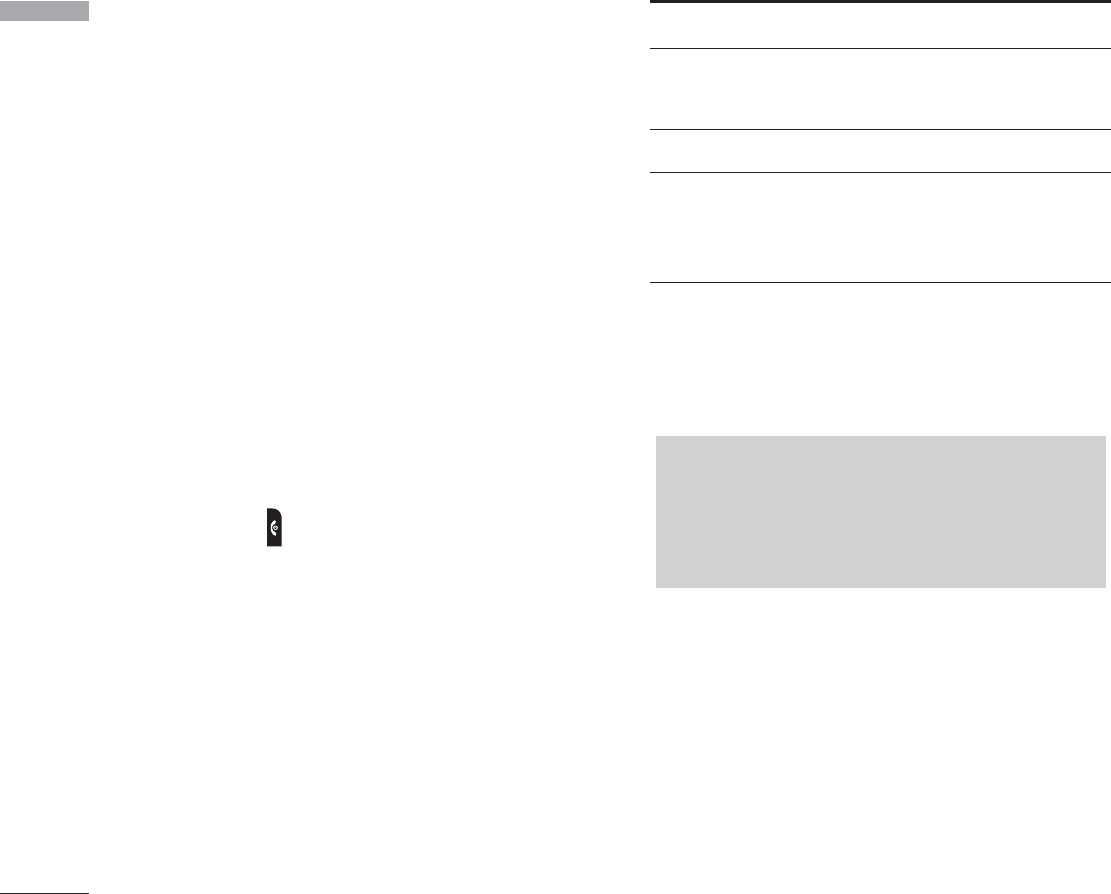
You can access various WAP (Wireless
Application Protocol) services such as
banking, news, weather reports and flight
information. These services are specially
designed for mobile phones and they are
maintained by WAP service providers.
Check the availability of WAP services, pricing
and tariffs with your network operator
and/or the service provider whose service
you wish to use. Service providers will also
give you instructions on how to use their
services.
Once connected, the homepage is displayed.
The content depends on the service
provider. To exit the browser at any time,
press the ( ) key. The phone will return
to the idle menu.
Navigating with the WAP browser
You can surf the Internet using either the
phone keys or the WAP browser menu.
Using the phone keys
When surfing the Internet, the phone keys
function differently to phone mode.
Key Description
ij
Scrolls each line of the content
area
b
Returns to the previous page
h
Selects options and
confirmptions and confirms
actions
Using the WAP browser menu
There are various menu options available
when surfing the Mobile Web.
Note
vThe WAP browser menus may vary,
depending on your browser version.
Browser
Browser
64

Home Menu 7.1
Connects to a homepage. The homepage will
be the site which is defined in the activated
profile. It will be defined by the service
provider if you have not defined it in the
activated profile.
Bookmarks Menu 7.2
This menu allows you to store the URL of
favourite web pages for easy access at a later
time.
To create a bookmark
1. Press the left soft key
d
[Options].
2. Select Add new and press the OK key.
3. After entering the desired URL and title,
press the OK key.
After selecting a desired bookmark, the
following options are available.
]
Connect: Connects to the selected
bookmark.
]
Add new: Select this to create a new
bookmark.
]
Edit: You can edit the URL and/or the title
of the selected bookmark.
]
Delete: Deletes the selected bookmark.
]
Delete all: Deletes all the bookmarks.
Go to URL Menu 7.3
You can connect directly to the site you
want. After entering a specific URL, press the
OK key.
Settings Menu 7.4
You can set the profile, cache, cookie and
security related to internet service.
Profiles (Menu 7.4.1)
A profile is the network information used to
connect to the Internet.
There are default profiles for some operators,
stored in phone memory. It’s impossible to
rename default profiles.
Browser
65

Each profile has submenus as follows:
]
Activate: Activates the selected profile.
]
Settings: Use this to edit and change WAP
settings for the selected profile.
- Homepage: This setting allows you to
enter the address (URL) of a site you
want to use as homepage. You do not
need to type http:// at the front of each
URL as the WAP Browser will
automatically add it.
- Bearer: You can set the bearer data
service. 1 Data/2 GPRS
- Data settings: Appears only if you select
Data Settings as a Bearer/service.
Dial number: Enter the telephone
number to dial to access your WAP
gateway.
User ID: The users identity for your dial-
up server (and NOT the WAP gateway).
Password: The password required by
your dial-up server (and NOT the WAP
gateway) to identify you.
Call type: Select the type of data call :
Analogue of Digital (ISDN).
Linger time: You need to enter timeout
period. After entering that, the WAP
navigation service will be unavailable if
any data is not input or transferred.
- GPRS settings: The service settings are
only available when GPRS is chosen as a
bearer service.
APN: Input the APN of the GPRS.
User ID: The users identify for your APN
server.
Password: The password required by
your APN server.
- Proxy settings
Proxy: Activates or cancels proxy.
IP address: Input the IP address of the
Proxy server you access.
Port number: Input the Proxy Port.
- DNS settings
Primary server: Input the IP address of
the primary DNS server you access.
Secondary server: Input the IP address
of the secondary DNS server you access.
Browser
Browser
66

]
Rename: You can change the profile name.
]
Add new: You can add a new profile.
]
Delete: Deletes the selected profile from
the list.
Cache (Menu 7.4.2)
The information or services you have
accessed are saved in the cache memory of
the phone.
Cookie (Menu 7.4.3)
The information or services you have
accessed are saved in the cache memory of
the phone.
Clear cache (Menu 7.4.4)
Removes all context saved in cache.
Clear cookie (Menu 7.4.5)
Removes all context saved in cookie.
Security (Menu 7.4.6)
A list of the available certification is shown.
]
Authority: You can see the list of
authority certificates that have been
stored in your phone.
]
Personal: You can see the list of personal
certificates that have been stored in your
phone.
Note
]
A cache is a buffer memory, which is
used to save data temporarily.
Browser
67

Games & apps Menu 8.1
Games & apps (Menu 8.1.1)
•Default Games: In this menu, you can
manage the Java applications installed in
your phone. You can play or delete
downloaded applications, or set the
connect option. The downloaded
applications are organised in folders.
Press the left soft key
d
[OK] to open
the selected slide or launch the selected
midlet.
After selecting a folder, press [Options] and
then sub menus available to several options
are displayed.
]
Open: You can see the stored games.
]
New folder: Create a new slide.
Profiles (Menu 8.1.2)
A profile is the network information used to
connect to the Internet.
If you want to see the details of a profile,
please refer to Menu 7.4.1.
My stuff
My stuff
68
Java
TM
, is a technology developed by Sun
Microsystems. Similar to the way you
would download the Java Applet using
the standard MS Internet Explorer
browsers, Java MIDlet can be
downloaded using a WAP enabled
phone. Depending on the service
provider, all Java based programs such as
Java games can be downloaded and run
on a phone. Once downloaded, the Java
program can be viewed in the
Games &
Apps
menu where you can select,
execute, or delete. The Java program
files saved in the phone are in .JAD or
.JAR format.

CAUTION!
Only J2ME(Java 2 Micro Edition) based
programs will run in a phone environment. The
J2SE(Java 2 Standard Edition) based programs
will only run in a PC environment.
Note
vThe JAR file is a compressed format of
the Java program and the JAD file is a
description file that includes all detailed
information. From the network, prior to
download, you can view all detailed file
descriptions from the JAD file.
vWhile being based on a standard
language (J2ME), not all Java
applications are compatible with all
handsets on sale insofar as specific
libraries may be used for a telephone
model. The software may be blocked or
switch itself on when Java applications
not specifically developed for the
phone this manual refers to are
downloaded, making it necessary to
“restart” the handset. We would like to
point out that these problems are
caused by incompatible applications
and are not a product fault.
My stuff
69
New Fantastic LG There is Mass Storage
function in the . if you connect the
USB cable, you can use the phone as a
Removable Disk.
You can download MP3 files, and photos,
video, txt files etc. this gives you fast
access from PC to Phone, by just
connecting the USB cable.
This function does not require the
installation of additional software.
1. Whilst the phone is displaying the
standby screen, connect the phone to
the PC using the supplied USB cable.
The PC should recognise the handset
within a few seconds.
2. The phone will display « USB » on the
screen.
3. The phone will be identified as «
Removable disk » in My Computer. The
PC should then treat the as a
standard drive allowing you to place
files to and from the handset's memory.
You can either use Window's drag and
drop or copy and paste methods to
transfer content.

My stuff
My stuff
70
Music
vYou can store music files in this folder.
vThe supported formats are:
MP3,AAC,AAC+,AAC++,
WMA,MP4(audio),Wav.
vThe files in this folder can be played
using the MP3 player and Playlist
features of the phone.
vIf you download an MP3 file to a
different folder, it will be not be
possible for the phone to locate and
play the file.
vDo not create subfolders here because
the MP3 files contained in that folder
will not be found and, therefore, will
unable to be played by the music
player.
vTo set an MP3 file as a ringtone then
please do the following on the handset:
options>Go to MP3 player>options>set
as ringtone.
4. Double click on « Removable disk » and
open. A folder called My media will be
displayed. Within that folder there are
a further 5 folders. Do not disconnect
the phone whilst a file transfer is in
progress, doing so may damage the
memory and corrupt the file.
5. When you want to disconnect the
phone from your PC, use Windows to
safely remove the handware and then
disconnect the USB cable from the
handset.
vIf you receive a call whilst in mass
storage mode, the call will be rejected.
Once the handset is disconnected, the
will display information about
any calls missed.
My media
In the My media folder you will find the
following 5 folders; Music, Others,
Photos, Text and Videos.
Do not change the names of these
folders, doing so will cause content stored
in them to not be seen by the handset.

My stuff
71
Others
vAny type of file can be stored here.
This folder is mainly used for
transporting files from one PC to
another.
vThe handset can preview JPG (Max
460K), GIF (Max 100K).
vYou can set an image file as wallpaper as
long as it does not exceed 30k in size,
for other formats please use the PC
Suite.
Photos
vThis folder is reserved for pictures taken
using the phone's digital camera.
vEven though photos can be uploaded
to this folder from your PC, they will not
be available on the phone's photo
album or My photos folder. Therefore,
we recommend that no photos are
uploaded to this folder.
Text
vThis folder supports .txt files. If you
place non .txt files here then the
handset will not display them.
Videos
vYou can download videos taken with
the phone's digital camera onto the PC
and upload new videos onto the phone.
vThis folder supports the 3GP file
format.
vYou can upload files of any size until the
memory is full.
vFiles stored in this folder can be
accessed by doing the following on the
handset: Menu>Multimedia>Video
album.

Videos Menu 8.2
Show the list of 3GP and MP4 files .
]
Play: You can play the video file by
pressing the OK key or selecting Play from
the Option menu.
]
Send via Bluetooth: Send the selected file
to another device via Bluetooth.
]
Rename: change the file name of the
selected file. The maximum length of
characters is 200. And You can not change
the extension of file.
]
Delete: Delete a file.
]
Delete all: Deletes all the files in the list
]
Information: Shows the file information.
Photos Menu 8.3
Shows the list of JPG files.
]
View: You can see the JPG file by pressing
the OK key or selecting View from the
Option menu.
]
Send via multimedia message: You can
write and send multimedia messages.
]
Send via Bluetooth: Send the selected file
to another device via Bluetooth.
Note
vTo setup .JPG (.JPEG) file from Photo
slide as wallpaper, go to Menu-
Multimedia-Photo album and then
please select Set as wallpaper in
Options menu.
Note
vThe maximum size of JPG file you can
see is 460Kbytes.
WARNING!
The following characters, \ / : * ? “ < > | can not be
used.
My stuff
My stuff
72

]
Rename: change the file name of selected
file. The maximum length of characters is
200. And You can not change the
extension of file.
]
Delete: Delete a file.
]
Delete all: Deletes all the files in the list
]
Information: Shows the file information.
Music Menu 8.4
Shows the list of MP3, MP4, AAC, M4A and
WMA files.
]
Play: You can play the MP3 file by pressing
the OK key or selecting Play from the
Option menu.
]
Send via Bluetooth: Send the selected file
to another device via Bluetooth
]
Rename: change the file name of selected
file. The maximum length of characters is
100. And You can not change the
extension of file.
]
Delete: Delete a file.
]
Delete all: Deletes all files in the list
]
Information: Shows the file information.
Tex t Menu 8.5
Show the list of TXT files.
]
View: You can see the TXT file by pressing
the OK key or selecting View from the
Option menu.
]
Send via Bluetooth: Send the selected file
to another device via Bluetooth.
]
Rename: change the file name of selected
file. The maximum length of characters is
100. And You can not change the
extension of file.
]
Delete: Delete a file.
]
Delete all: Delete all files in the list
]
Information: Show the file information.
Note
vThe maximum size of TXT file you can
see is 460Kbytes.
My stuff
73

Images Menu 8.6
After selecting a image, press the left key
d
[View] and then you can check the
options as follow:
]
Set as wallpaper: Currently selected
image can be set as a wallpaper.
]
Write messages: The images downloaded
from the network can be sent by
Multimedia. Maximum message size is 100
kb for MMS message.
]
Send via Bluetooth: The sound
downloaded from network can be sent by
Bluetooth.
Sounds Menu 8.7
After selecting a sound, press the left key
[Options].
You can check the options as follow:
]
Set as ringtone: Currently selected sound
can be set as a ringtone.
]
Write messages: The sound downloaded
from network can be sent by SMS or MMS.
Maximum MMS message is 100 kb.
]
Send via Bluetooth: The sound
downloaded from network can be sent by
Bluetooth.
My stuff
My stuff
74

Others Menu 8.8
Any type of file can be stored here. This
folder is mainly used for transporting files
from one PC to another.
]
View: You can view a file if it is one of the
following types; JPG, GIF, WBMP, PNG and
TXT. The handset can preview JPG (Max
460K), GIF (Max 100K).
]
Send via Bluetooth: Send the selected file
to another device via Bluetooth
My stuff
75

Date & time Menu 9.1
You can set functions relating to the date
and time.
Date (Menu 9.1.1)
Set date
You can enter the current date.
Date format
You can set the Date format such as
DD/MM/YYYY, MM/DD/YYYY,
YYYY/MM/DD.
(D: Day / M: Month / Y: Year)
Time (Menu 9.1.2)
Set time
You can enter the current time.
Time format
Your can set the time format between 24-
hour and 12-hour.
Display MENU 9.2
Wallpaper (Menu 9.2.1)
You can select the background pictures in
standby mode.
]
Default: You can select a picture or an
animation of wallpaper by pressing
k
or
l
.
]
My folder: You can select a picture or an
animation as wallpaper.
Menu colour (Menu 9.2.2)
Your phone provides you with 4 menu colour
themes. Set the menu colour by scrolling and
pressing the left soft key
d
[OK].
Standby text (Menu 9.2.3)
If you select On, you can edit the text which
is displayed in standby mode.
Settings
Settings
76

Backlight (Menu 9.2.4)
You can set the light-up duration of the
display.
Brightness (Menu 9.2.5)
The screen brightness can be adjusted from
40% to 100%.
Network name (Menu 9.2.6)
If this function is activated, network name will
be displayed on main LCD.
Home screen shortcut (Menu 9.2.7)
Selecting On displays the functionalities of 4
Navigation keys and Menu key as pictures on
the middle of the idle window.
Dial font colour (Menu 9.2.8)
You can set the colour of displayed number
when press the number keys in idle state for
call connection.
Power saving Menu 9.3
This function saves battery power by keeping
backlight brightness to max 40%.
Language Menu 9.4
You can change the language for the display
texts in your phone. This change will also
affect the Language Input mode.
Connectivity Menu 9.5
Bluetooth (Menu 9.5.1)
Bluetooth enables compatible mobile
devices, peripherals and computers that are
in close proximity to communicate directly
with each other without wires. This handset
supports built-in Bluetooth connectivity,
which makes it possible to connect them with
compatible Bluetooth headsets, computer
applications and so on.
Settings
77

Set Bluetooth
You can activate or cancel the Bluetooth
function.
Paired devices/Handsfree devices
You can view all devices which your is
already paired to.
If you have entered Paired devices or
Handsfree devices, you will see the following
options in both those menus.
]
Connect/Disconnect: Allows you to
connect to your paired Bluetooth devices.
]
Add new: Allows you to search for new
Bluetooth devices and add them to your
phone's list of paired devices. When you
select Add new your handset will start to
search for Bluetooth devices within range.
Once the device you wish to pair appears
on the list press the right soft key [Stop].
Scroll to the desired device and press the
left soft key [Pair]. You will then be asked
to enter a passcode. The passcode can be
any code you wish to use (the same
passcode must be used by both devices) or
is one that is pre-determined by the
Note
vIf you use LG PC Sync via Bluetooth,
you can exchange data only within the
phonebook.
vWhen you receive data from another
Bluetooth device, the phone requests
confirmation. After confirming the
transfer, the file will be copied on to
your phone.
vDepending on the file type, it will be
stored in the following folders:
-MP3 (.mp3, mp4, aac, m4a, wma):
Music folder.
-Video (.3GP, MP4): video folder.
-Phonebook contacts (.VCF):
Phonebook.
-Text (.txt): Text folder.
-Other files (.*.*): File storage folder.
vThe handset normally operates with
WIDCOMM driver(version 1.4.3.4) or
WIDCOMM driver(version 1.4.2.10).
And it does not support the LG
Contents Bank with Bluetooth.
Settings
Settings
78

manufacturer of the device you are trying
to pair with. Please check the User Manual
of the device you are initiating the pair with
to see if it already has a predetermined
passcode in place.
]
Assign name: Allows you to change the
name of the paired Bluetooth device and
how it is displayed on the handset.
]
Set as authorised/Set as unauthorised:
Allows you to set an authorised connection
between each Bluetooth device. For
example if you regularly use a Bluetooth
headset with your phone then setting the
connection as authorised will mean the
headset will automatically connect to the
handset each time the headset is powered
on.
]
All services: Allows you to view all services
which are supported by a Bluetooth
device.
]
Delete: Allows you to delete a paired
Bluetooth device.
]
Delete all: Allows you to delete all paired
Bluetooth devices.
Settings
]
My handset’s visibility
This indicates whether or not your handset
will be visible to other Bluetooth devices.
]
My handset’s name
You can set the name of your Bluetooth
device. The default name is LG
Supported services
Displays a list of Bluetooth services the
handset supports.
]
Headset
]
Handsfree kit
]
File transfer
]
Image printing
]
Dial-up networking
]
Business card transfer
]
Browsing other device
]
Serial Port Profile
Settings
79

Modem (Menu 9.5.2)
You can access the network services through
the Modem. If you want to use the LG PC
Sync, Contents bank or Internet Cube, you
should access the menu and activate the
modem and then plug in the USB cable.
Network (Menu 9.5.3)
You can select a network which will be
registered either automatically or manually.
Usually, the network selection is set to
Automatic.
Network selection
You can select a network type.
]
Automatic:
If you select Automatic
mode, the phone will automatically search
for and select a network for you. Once you
have selected “Automatic”, the phone will
be set to “Automatic” even though the
power is off and on.
]
Manual:
The phone will find the list of
available networks and show you them.
Then you can select the network which you
want to use if this network has a roaming
agreement with your home network
operator. The phone let you select another
network if the phone fails to access the
selected network.
]
Preferred:
You can set a list of preferred
networks and the phone attempts to
register with first, before attempting to
register to any other networks. This list is
set from the phone’s predefined list of
known networks.
Band selection
]
EGSM/DCS: Depending on Network
situation, you can select EGSM/DCS.
]
PCS only: Depending on Network
situation, you can select PCS only.
Settings
Settings
80

GPRS attach (Menu 9.5.4)
You can set GPRS service depending on
various situations.
Switch on
If you select this menu, the phone is
automatically registered to a GPRS network
when you switch the phone on. Starting a
WAP or PC dial-up application created the
connection between phone and network and
data transfer is possible. When you end the
application, GPRS connection is ended but
the registration to the GPRS network
remains.
When needed
If you select this menu, the GPRS connection
is established when you connect a WAP
service and closed when you end the WAP
connection.
Calling Menu 9.6
Call divert (Menu 9.6.1)
The Call divert service allows you to divert
incoming voice calls, fax calls, and data calls
to another number. For details, contact your
service provider.
]
All voice calls
Diverts voice calls unconditionally.
]
If busy
Diverts voice calls when the phone is in
use.
]
If no reply
Diverts voice calls which you do not
answer.
]
If out of reach
Diverts voice calls when the phone is
switched off or out of coverage.
]
All data calls
Diverts to a number with a PC connection
unconditionally.
Settings
81

]
All fax calls
Diverts to a number with a fax connection
unconditionally.
]
Cancel all
Cancels all call divert service.
The submenus
Call divert menus have the submenus shown
below.
• Activate
Activate the corresponding service.
To voice mail centre
Forwards to message centre. This function
is not shown at All data calls and All fax calls
menus.
To other number
Inputs the number for diverting.
To favourite number
You can check back to last five diverted
numbers.
• Cancel
Deactivate the corresponding service.
• View status
View the status of the corresponding
service.
Answer mode (Menu 9.6.2)
]
Slide up
If you select this menu, you can receive an
incoming call when you open the slide.
]
Any key
If you select this menu, you can receive a
call by pressing any key except [End]
key.
]
Send key only
If you select this menu, you can receive a
call by only pressing
a
[Send] key.
Send my number (Menu 9.6.3)
(network and subscription dependent)
]
Set by network
If you select this, you can send your phone
number depending on two line service such
as line 1 or line 2.
Settings
Settings
82

]
On
You can send your phone number to
another party. Your phone number will be
shown on the receiver’s phone.
]
Off
Your phone number will not be shown.
Call waiting (Menu 9.6.4)
(network dependent)
]
Activate
If you select Activate, you can accept a
waiting (receiving) call.
]
Cancel
If you select Cancel, you cannot recognize
the waiting (receiving) call.
]
View status
Shows the status of Call waiting.
Minute minder (Menu 9.6.5)
If you select On, you can check the call
duration by a beep sound given every minute
during a call.
Auto redial (Menu 9.6.6)
]
On
When this function is activated, the phone
will automatically try to redial in the case
of failure to connect a call.
]
Off
Your phone will not make any attempts to
redial when the original call has not
connected.
Security Menu 9.7
PIN code request (Menu 9.7.1)
In this menu, you can set the phone to ask for
the PIN code of your SIM card when the
phone is switched on.
If this function is activated, you’ll be
requested to enter the PIN code.
1. Select PIN code request in the security
settings menu, and then press
d
[OK].
2. Set Enable/Disable
Settings
83

3. If you want to change the setting, you
need to enter PIN code when you switch
on the phone.
4. If you enter wrong PIN code more than 3
times, the phone will lock out. If the PIN is
blocked, you will need to key in PUK code.
5. You can enter your PUK code up to 10
times. If you put wrong PUK code more
than 10 times, you can not unlock your
phone. You will need to contact your
service provider.
Handset lock (Menu 9.7.2)
You can use a security code to avoid
unauthorised use of the phone. Whenever
you switch on the phone, the phone will
request security code if you set phone lock
to When switch on.
If you set phone lock to When SIM changed,
your phone will request security code only
when you change your SIM card.
Call barring (Menu 9.7.3)
The Call barring service prevents your phone
from making or receiving certain category of
calls. This function requires the call barring
password. You can view the following
submenus.
]
All outgoing calls
The barring service for all outgoing calls.
]
Outgoing international
The barring service for all outgoing
international calls.
]
Outgoing international when roaming
The barring service for all international
outgoing calls except home network.
]
All incoming
The barring service for all incoming calls.
]
Incoming when roaming
The barring service for all incoming calls
when roaming.
]
Cancel all
You can cancel all barring services.
]
Change password
You can change the password for Call
Barring Service.
Settings
Settings
84

The submenus:
• Activate
Allows to request the network to set call
restriction on.
• Cancel
Set the selected call restriction off.
• View status
View the status whether the calls are barred
or not.
Fixed dial number (Menu 9.7.4)
(SIM dependent)
You can restrict your outgoing calls to
selected phone numbers. The numbers are
protected by your PIN2 code. The numbers
you wish to allow access to once this service
has been enabled, must be added to the
contacts after enabling Fixed dial number.
]
Enable
You can restrict your outgoing calls to
selected phone numbers.
]
Disable
You can cancel fixed dialling function.
]
Number list
You can view the number list saved as
Fixed dial number.
Change codes (Menu 9.7.5)
PIN is an abbreviation of Personal
Identification Number to prevent use by
unauthorised person. You can change the
access codes: Security code, PIN code,
PIN2 code.
1. If you want to change the Security
code/PIN1/ PIN2 code input your original
code, and then press
d
[OK].
2. Input new Security code/PIN1/PIN2 code
and verify them.
Touchpad lock (Menu 9.7.6)
Sets whether to use the touch pad when
closing a slide.
On: It is impossible to activate the touch pad
with slide closed. (You can use the touch
pad only when slide opens.)
Off: It is possible to activate the touch pad
using the Volume key even with slide
closed.
Settings
85

Memory status Menu 9.8
You can check free space and memory usage
of each repository, Internal memory,
Multimedia memory. You can go to each
repository menu.
Reset settings Menu 9.9
You can initialise all factory defaults. You will
need the Security code to activate this
function.
]
Restore default settings: Allows you to
restore the phone back to its default
settings.
]
Clear multimedia memory: Allows you to
format the multimedia memory and create
a default directory.
Settings
Settings
86
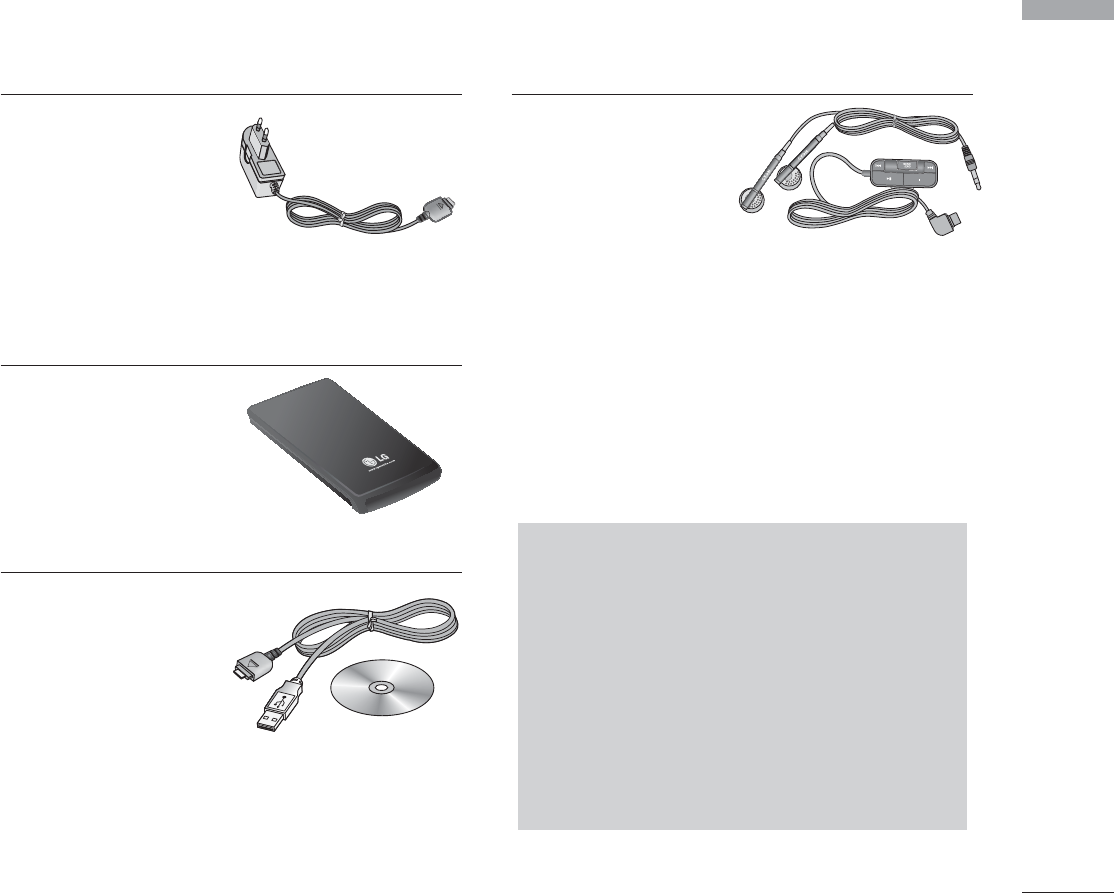
Accessories
Accessories
87
Travel Adapter
This charger allows
you to charge the
battery while away
from home or your
office.
Standard
Battery
Data cable/CD
You can connect
your phone to PC to
exchange the data
between them.
Hands free ear-
microphone and
music player
controller combo
Stereo headset
Controller: Answer & End button, music
player control, volume control, Hold button
and microphone.
After connecting the headset and the
controller, plug the end of controller into the
headset jack on the right side of the phone.
Note
vAlways use genuine LG accessories.
vFailure to do so may invalidate your
warranty.
vAccessories may vary in different
regions; please check with our regional
service company or agent for further
information.
There are various accessories for your mobile phone. You can select these options
according to your personal communication requirements.